To celebrate my post 4000 (what a spammer, aye?) at EEVBlog forum, I've decided to share my experience with national level calibration. As many volt-nuts know, 2019 is a special year, since SI electrical units changed their definition and become effective 20 May 2019. Even though the practical impact to everyday calibrations is nearly invisible, it is a good excuse to finally align my home lab standards and equipment to intrinsic standards, such as quantum voltage system and quantum resistance system.
Beware, lots of metrology photos, NSFW indeed.

This thread is done as part of
xDevs.com's Volt/Ohm calibration verification to get volt-nuts feedback.
What is SI, and where it comes from?To ensure agreement between measurement results of all possible physical parameters, people in 1875 started development and use of the single metric system, known today as
The International System of Units (abbreviated SI). This SI system applied worldwide to ensure that products developed across the world are measured the same way and have the same quality. If you buy 1 kilogram of gold from France bank to sell in Australia, SI ensures than a bank in Australia also accounts it as 1 kilogram of gold, not 980 gram or 1010 gram. Every person who ended up with metric screws but imperial nuts already know why a single system is very important.

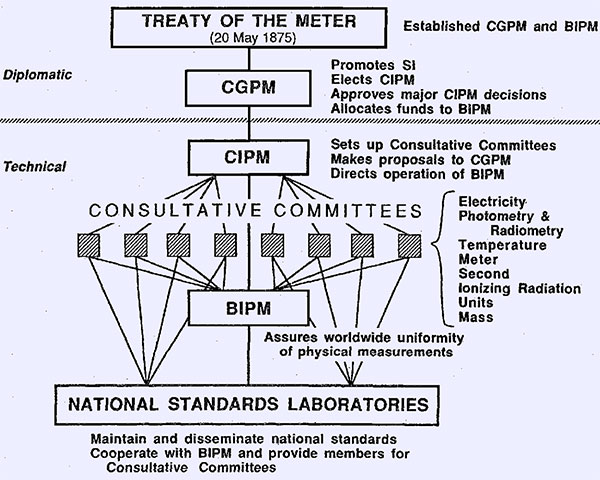
SI defines 7 base units, ampere, candela, kelvin, kilogram, meter, mole and second. Other derived units are defined in relation to these seven base units. The base units are derived from intrinsic constants of nature, like the speed of light in vacuum or charge of the electron, which is observed and measured with great accuracy by international research teams and scientists. With carefully defined units, measurements of practical standards and artifacts existing today are possible to uncertainty better than a few parts per billion. In percentage units that is tiny 0.0000001%! So the reader may ask, why such measurement accuracy is so important, and why engineers may need to know a quantity with 0.0000001% accuracy? Well, this is not that simple.

Perhaps we don't need measurement with 0.0000001% accuracy. Speedometer that shows speed in the car may have accuracy just 1%. However, speedometer manufacturer must verify and certify that each meter leaving production line indeed meets 1% level accuracy. This is possible when the production line has own speed measurement accuracy better, for example at 0.1%, to provide an accurate test for each speedometer device under test (DUT). But how the factory can know they use 0.1% accurate equipment? To resolve this question, the factory will send their equipment to industry calibration lab, shown by metrology hierarchy triangle. This next-level calibration lab that test production line equipment must have accurate methods to test speed with an error of less than 0.01%. Still, the task is not over here and measurements eventually build a long chain of labs and results, till the direct comparison with the realization of base or derived SI units at national and international level for the final *traceable* calibration step.
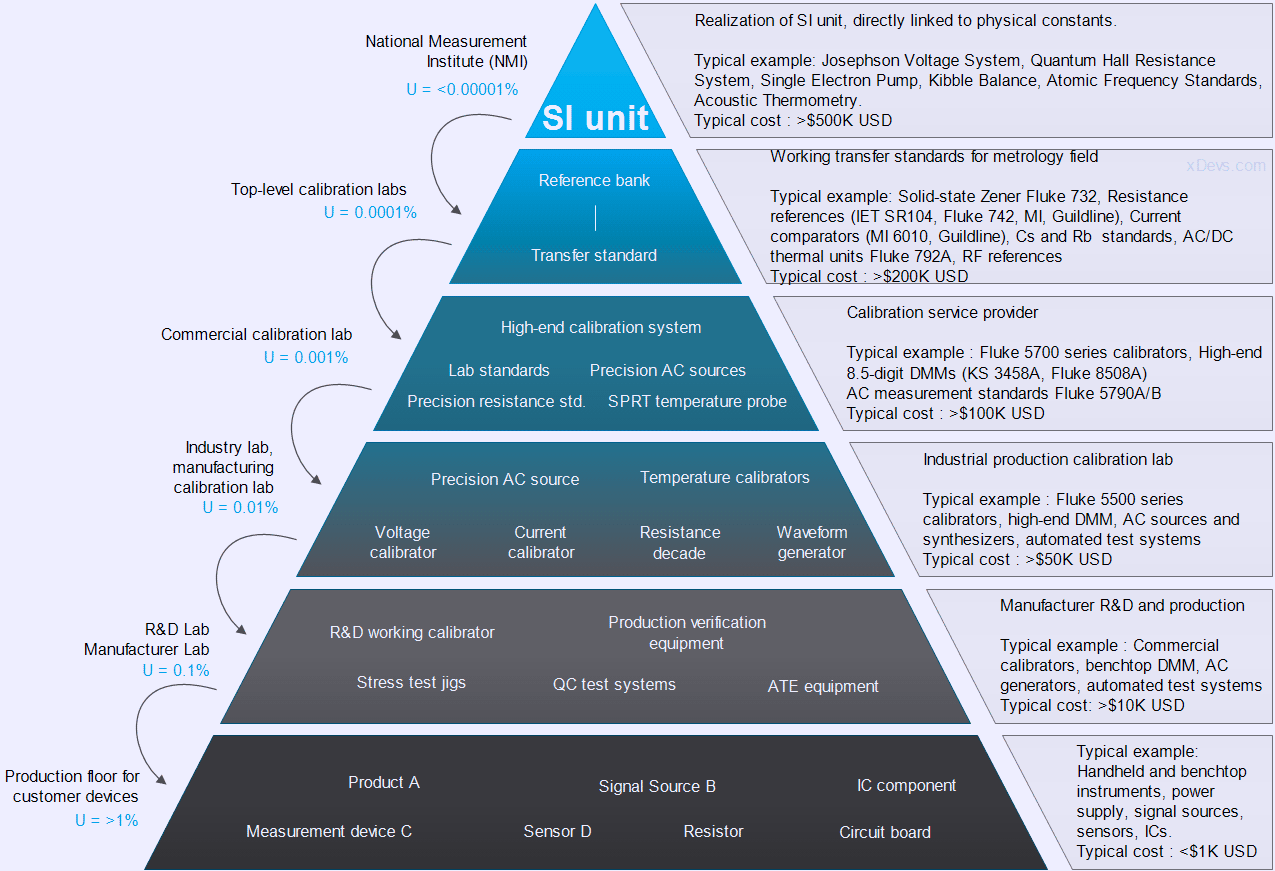
In other words - every measurement always has an error. Traceability and calibrations provide a way to estimate the magnitude of that error. Measurements performed on a higher level, closer to SI unit implementation, performed with higher-grade equipment can offer better measurement uncertainty (smaller error of measurement) and account for more error factors.
However, the cost of making better measurements increase a lot as well, requiring more time and more expensive delicate equipment with severe maintenance and operation costs, especially compared to typical commercial level calibrators and sources. With every next level amount of factors that must be accounted for measurement uncertainty budget are multiplying, transforming total error estimation into difficult statistics and the time-correlated math task. Add labor costs, logistics, no wonder why cost goes in magnitude when you jump into next decimal digit of
accuracy in measurement. There are thousands of meters that provide 1% or even 0.1% accuracy levels, but only a handful of expensive instruments and manufacturers that can offer 0.001% accuracy.
Now the top base SI units are updated and at
International Metrology Day - May 20, 2019 new SI units
become effective, moving away from human-made artifacts. Aging/drift errors in artifact standards can no longer impact SI unit definition after
May 20, 2019.


SI system units before (left) and after 20 May 2019 (right).
CreditsGray circles on old SI graph represent physical artifacts, such as
International Prototype of the Kilogram or triple point of water, ~+0.01 °C. These artifacts produce extremely stable reference values, but being non-ideal macroscopic objects, they are not constant and still drift by tiny, yet detectable amount.
Change of the SI unit, in theory, affects complete hierarchy and all previous calibration results, but in practical applications deviation is so small, that even top-level calibration laboratory might not be able to see the difference between previous SI and new SI. There is no need to worry about measurement error in typical handheld DMMs or power supplies because their own stability and accuracy are magnitudes worse than the induced deviation from new SI 2019. We expect that redefinition in SI units would only affect measurements by national measurement laboratories and international scientific research projects that work with top-notch instrumentation to detect sub-ppm (<0.0001%) change, and not affect most commercial applications.
Calibrating our standards, cooperation with NMLTo celebrate this major change xDevs.com project team finally committed to obtaining direct voltage and resistance calibration transfer to National Level Quantum standards. This is not as easy as may sound, so this article only covers these two derived units, volt V and resistance Ohm.
SI units’ redefinition makes 2019 special year for electricity field, as the last change of similar significance for voltage and resistance was 29 years ago with the implementation of SI-1990 change for Volt and Ohm. Cooperation with Taiwan's
National Measurement Laboratory (NML), Industrial Technology Research Institute (ITRI) made this calibration service and this publication possible.

Voltage and Resistance are derived units from
redefined Ampere . The Ampere, symbol A, is the SI unit of electric current. It is defined by taking the fixed numerical value of the elementary charge e exactly 1.602176634 × 10-19 when expressed in the unit C, which is equal to A s, where the second is defined in terms of ΔνCs.
SI Voltage unitVoltage is the potential difference between two points in the electric circuit. The amount of difference, expressed in units Volt (symbol V) indicate amount of potential energy that moves electrons from one point in the circuit to another. As result voltage identifies how much work, potentially, can be done through the electric circuit. If we imagine an electric conductor as the water pipe, the voltage would be the diameter of the pipe. Voltage unit is named after physicist Alessandro Volta (1745-1827), who invented the voltaic pile – ancient equivalent of the today battery cell.
Resistance is a measure opposite to current flow in an electrical circuit. It is expressed in units Ohm (symbol Ω). With same voltage in the circuit, a higher resistance in the path will reduce the amount of electron flow (current), while lower resistance would increase current flow. If we imagine an electric conductor as the same water pipe, resistance equivalent would be amount of valve opening. Ohms are named after physicist Georg Simon Ohm (1784-1854) who studied the relationship between voltage, current and resistance and formulated famous Ohm’s Law.
If we extend the water pipe example to Current, that is the amount of water, flowing thru the pipe. Current is expressed in units Ampere (symbol A). Current defines the number of electrons flowing past a point in a circuit over a given time. A current of 1 Ampere means that 1 coulomb (6.241509126(38) × 10e+18 electrons) is moving past a single point in a circuit per 1 second.
Here we will touch on SI unit redefinition 2019 in terms of voltage and resistance and practical impact on the calibration applications. SI unit volt (V) realized using the quantum Josephson effect discovered in 1973, with the help of the cryogenic system and the new value of the Josephson constant.
KJ = 2e/h = 483597.848416984 GHz V-1
From SI redefinition elementary charge e is now equal 1.6021766341 × 10-19 coulomb exactly, and Planck constant h is 6.626070150 × 10-34 J Hz-1 exactly. The advantage of new value of KJ for practical use is that it ensures that virtually all realizations of the volt unit, based on the Josephson effect will provide exactly the same result.
Old pre-2019 value, which was adopted by CIPM starting 1 January 1990 KJ-90 = 483597.9 GHz V-1 is larger by the fractional amount 106.665 ppb(parts per billion). This implies that the new unit of voltage realized after 20 May 2019 using updated KJ now smaller by the same fractional amount -106.665 ppb.
This small, but detectable change would affect only highest-precision calibration systems, used in top-level labs that obtain and maintain calibrations with fractional 10-6 (1 ppm) uncertainty for DC voltage. Other than JVS system itself, a typical example of such realizations are predicted reference voltages from banks of four or more Fluke 732 (734A/C), Datron 4910 series and Wavetek/Fluke 7004/7010N series arrays, that are constantly powered and monitored for on-site lab’s Volt value. In more practical cases, even very expensive 8½-digit DMMs like Keysight 3458A or Fluke 8508A such small change would be already masked by their own zener reference noise, thermal coefficient, and errors of the measurement path and ADC.
SI Resistance unitThe unit of resistance, ohm Ω can be realized by using the Quantum Hall effect and the following new value of the von Klitzing constant RK.
RK = h/e2 = 25812.8074593045 Ω
Old value RK-90 = 25812.807 Ω was adopted by the CIPM starting 1 January 1990 for the international realization of the Ohm. Change of the new RK is the fractional amount +17.793 ppb(parts per billion). This implies that the unit of resistance realized after 20 May 2019 using new RK is larger by the same fractional amount.
This change can be detected only by direct current comparator bridges and ratiometric systems, so for practical commercial calibration labs change of SI resistance unit have a smaller impact than voltage, because the annual drift of best conventional resistance standards is usually worse than this The impact from Ohm unit change is even less than voltage, so this has a minimal practical impact on commercial calibration labs and their operations.
These formulae and calculations look simple and easy, but in real life many NMIs and collaborations worked years, if not decades to establish a direct connection between the fundamental physical constants and macroscopic experiments to provide transfers and comparisons to have traceable uncertainty less than 10-8 or better. These efforts allowed the international metrology community to move from human-made artifacts definitions in 2018-2019 to basic constants of nature. universal for the world. Eventually old international artifact standards like International Prototype of the Kilogram will find their place in museum as important history piece.
BIPM also has released
guidance document explaining impact from redefined SI units for voltage and resistance.
xDevs.com labs primary standards used for calibration, used as reference sourcesHow that theory is briefly covered, we can move to the practical experiments and calibrations. xDevs.com have two equally important private labs, located in the USA and Taiwan, where most of the test equipment you see on this site is tested and fixed. Lot of gear setups between both labs similar and overlapping in voltage and resistance capability. Both labs running daily for educational and research purpose, to study metrology-relevant topics, such as stability of the solid-state zener reference designs, resistance standards testing, various experiments to explore instrumentation limits and perform data analytics for precision applications.
As part of the lab maintenance, we do internal instruments repair and calibration in-house, including extensive component level and custom electronics hardware development. Most of the equipment controlled 24/7 with in-house Python software, running on dedicated data collection computers such as Raspberry Pi and GPIB networks. Covering complete lab details is outside of this article scope, however, it is important to note key primary DC and resistance standards used as calibration references for all underlying transfers.
Fluke 732B – 10 VDC and 1.018 VDC output reference. Industry-proven DC voltage standard, widely used by many calibration and metrology labs all around the world. Usually able to deliver stability better than ±2 ppm a year with predictable linear drift.
In theory any source, even generic battery cell can be calibrated (measured) with use of the highest precision system, however that exercise does not have many purposes as tested device drifts outside of measurement uncertainty very fast. Multiple stable calibration sources are often used at metrology labs for redundancy and cross-verification. If an ensemble of four references is holding accurate value, according to statistics, it is less likely that all four would drift same way. If any single reference in bank start showing unexpected behavior due to electrical or physical damage/stress this can be detected by comparing to other references, even before the next calibration cycle to SI Volt transfer.
Also ambient and standard temperature, humidity, pressure, loading current and even type of cable and physical stress on chassis are affecting output value of the standard. To reduce the impact of temperature and humidity most of commercial DC Voltage references equipped with built-in temperature ovens that maintain solid-state special circuit and critical components. These ovenized references such as Fluke 732 series have backup battery power, which limits shipping/transit time and impose regulations on safety.
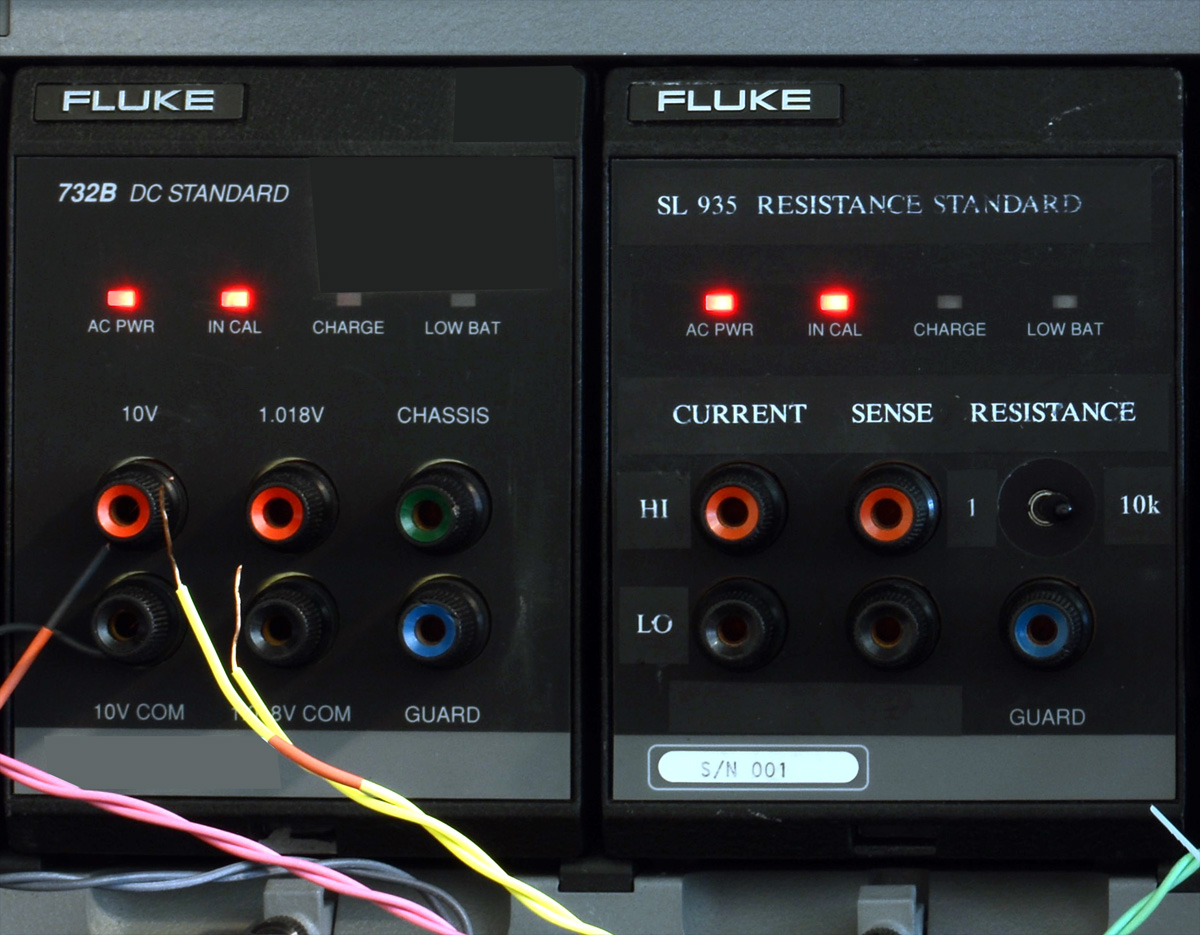
Prototype Fluke SL935 ovenized resistance standard , with 1 Ω and 10 KΩ output. This prototype device build by secret Fluke lab, using hermetic thin-film laser trimmed resistor networks from no less than ten (!) Fluke 5720A calibrators to obtain ultra-low temperature coefficient and stability for both output values. Unit is built around 732B reference chassis, replacing original DC Voltage reference electronics with custom resistance module. Oven operating at reduced temperature, fixed around 40 °C to reduce annual drift.
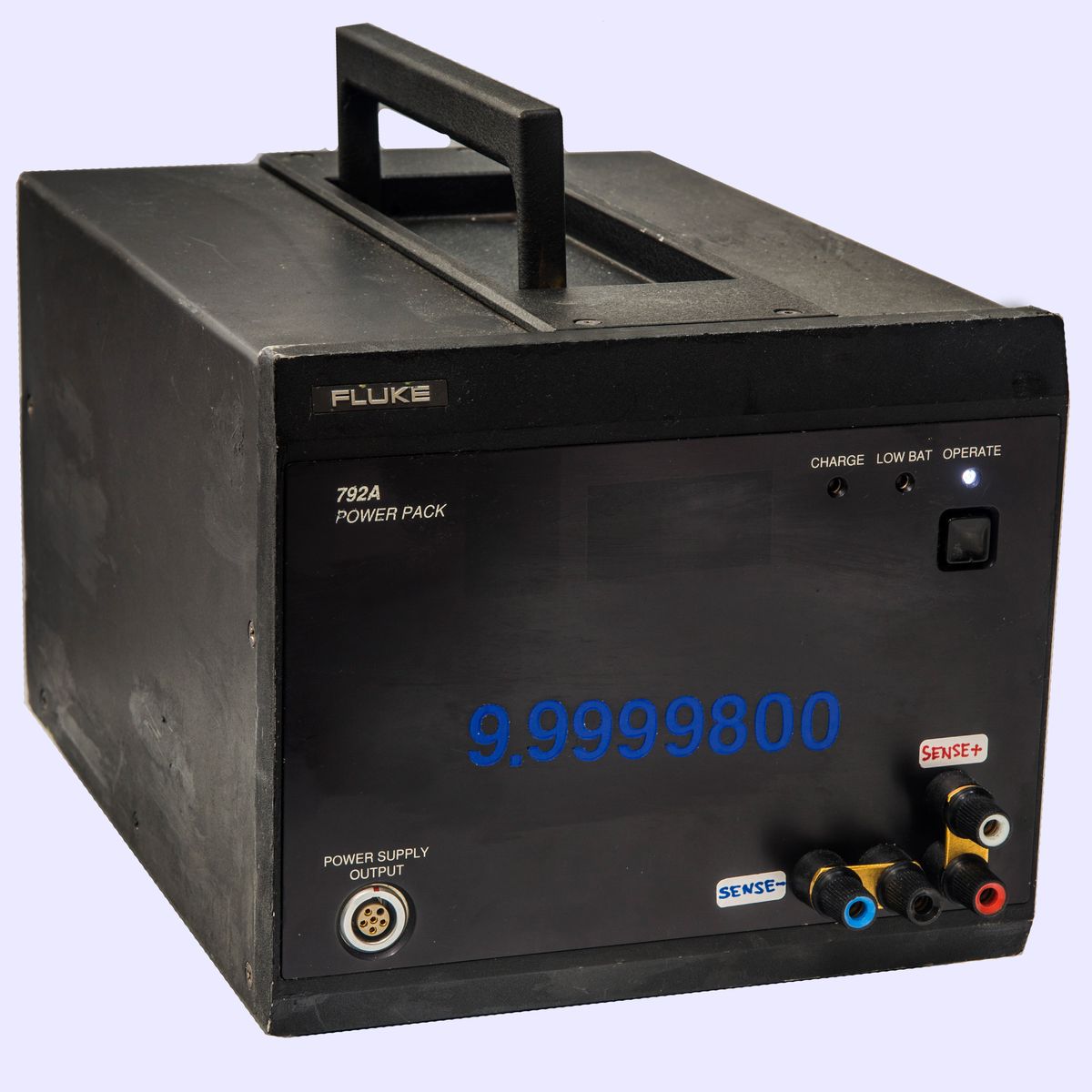
Over last few years here at xDevs.com lot of experiments were completed with our own custom designs in search of the ultimate stability DC voltage reference. Most of these utilize best reference on the market – Analog Device (former Linear Technology) LTZ1000 and LTZ1000A Super-Zener. Some publications about these designs available
here,
here and
here. These designs
demonstrated short-term stability within 1 ppm over period of days/weeks, with errors mostly induced by environment and measurement setups, rather than reference itself.
One such prototype
xDevs.com 792X FX LTZ1000A reference, assembled in Fluke 792A Power Pack. This standard provides +10 VDC nominal, with estimated annual drift less than -3 ppm. Key feature is high output drive capability with minimal loading errors, due to use of true 4-wire Kelvin connection output. Unlike Fluke 732B, this unit is able to sink or source currents up to 25 mADC with minimal error to the output voltage.
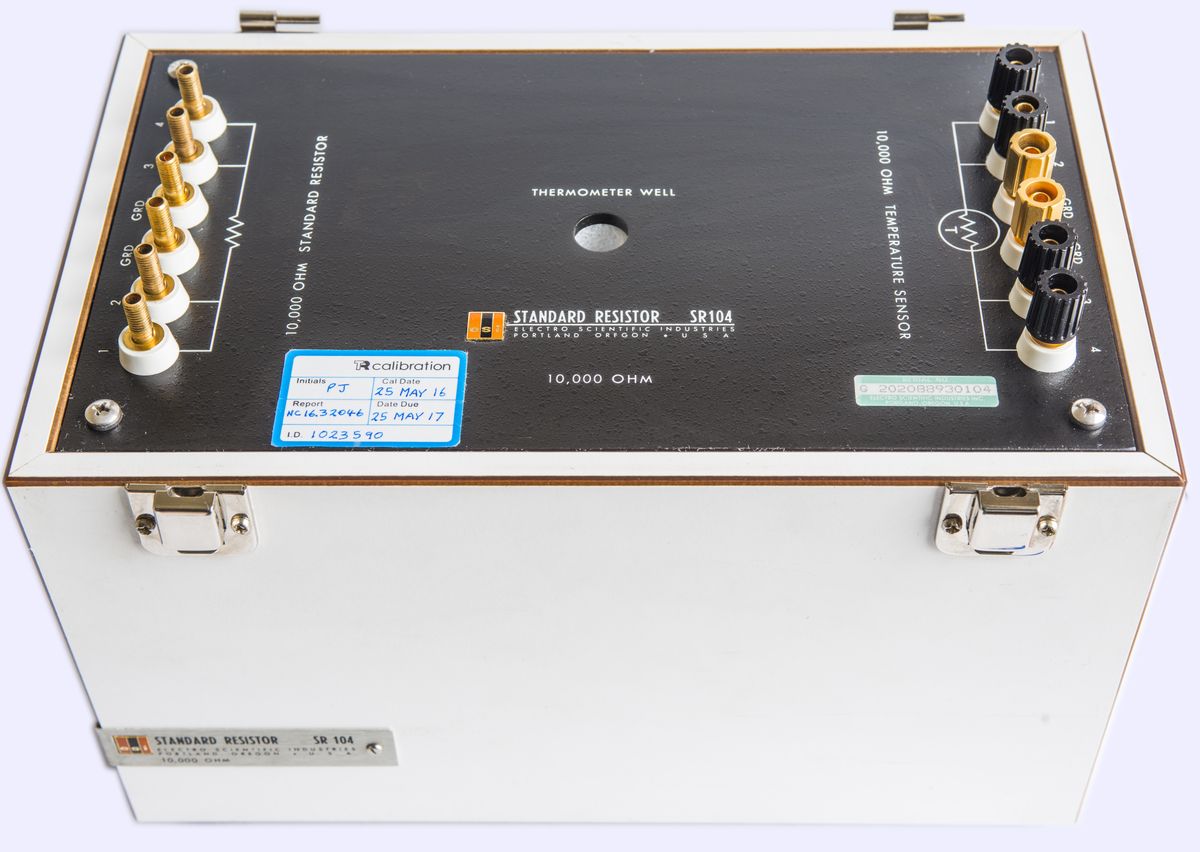 ESI SR104
ESI SR104 – resistance standard with the ultra-stable resistive element, temperature sensor, all enclosed in a sealed oil-filled metal can. Everything is embedded in nice wooden box (there is an option from IET without wooden enclosure as well). ESI, being one of the industry original experts in resistance field, invented and designed legendary SR104 10000 Ω resistance standard in 1967, considered as metrology primary level grade product by many labs. This standard is still unrivaled on the market, 52 years since. Perhaps that shows how hard it is to make improvements on high-end metrology instrumentation. For fun comparison – Intel 4004 processor, released well 4 years after ESI SR104 evolved into modern 56-core+ monsters on 14nm process.
Often units with original manufacturing date codes before 1990 are still found within specifications. Thanks to rugged construction and own oil tank, these standards are not subjected to humidity variations and can provide ~0.2 ppm resistance accuracy after careful tempco compensation using an integrated sensor resistance element. TEGAM has acquired resistance products from ESI, which in turn by the year 2006 were sold to IET Labs Inc.
IET Labs now still offer these resistance standards together with A2LA accredited calibration services covering not just SR104 but all complementary resistance, inductance, and capacitance standards. Along with SR104 Primary Standards Resistors other models are also maintained, such as 100 Ω SR102, SR1010, SR1030, SR1050 Working Resistance Standards, SR1 Decade Boxes RS925D, DB62, DB877 Kelvin Varley Dividers DP1211-DP1311, 242D, 240C bridges.
Modern day IET SR104 however is not the same standard as designed by ESI, and original special wire-wound element was replaced by number of modern bulk metal foil elements, so new IET SR104 long term stability (years) will remain to be proven.
Transport standard to NML and calibration service.I had two rounds for calibration:
* Round 1 - May 2019, 732B and SR104. I've used these standards to calibrate/verify all my main gear (5720A,5725A,four 3458A and Datron 1281/4920M + standards for round 2)
* Round 2 - August 2019, 792X DC ref, SL935 resistance ref.
All standards were hand-carried to metrology laboratory in Hsinchu, Taiwan to minimize transport time, reduce the chance of shipping damage and maintain less environmental stress in transit.
Dr. Shih-Fang Chen and NML team then performed measurements, using updated SI 2019 constants from their Quantum References. NML’s best uncertainty is 9.8 nV/V and 0.15 µΩ/Ω, but our final calibration result is little worse due to measurement setup and own standards instability. For those who are more familiar with typical daily life accuracy representation, this means that NML can perform calibration with error 0.0000098% for DC Voltage, 0.000015% for Resistance, which is extremely small. For comparison typical industrial digital multimeter, such as Fluke 87V have accuracy ±0.05% for DCV function or ±0.2% for Resistance (and cost also 2000 times less).
Maintaining such measurement uncertainty in any lab for the absolute unit of SI Volt and Ohm is only possible by performing periodic verification with short calibration periods. And if the transfer standard has proven and verified very good stability and performance such verification can be done in cooperation with National Measurement Lab (NML) that maintain national reference standards.
Most of the nations have their own top-level laboratory responsible for this work. Widely known national labs are
NIST in USA,
PTB in Germany,
LNE in France. One can find more information about national labs from
BIPM KCDB database.
ITRI CMS laboratory is located in Hsinchu, the same city that have infamous TSMC fabs and also many other major semiconductor industry corporations. It was a short trip from Taipei on the High-Speed Rail (~25 minutes, $28 USD ticket) and taxi from HSR station to CMS (~20 minutes, $10 USD fare).

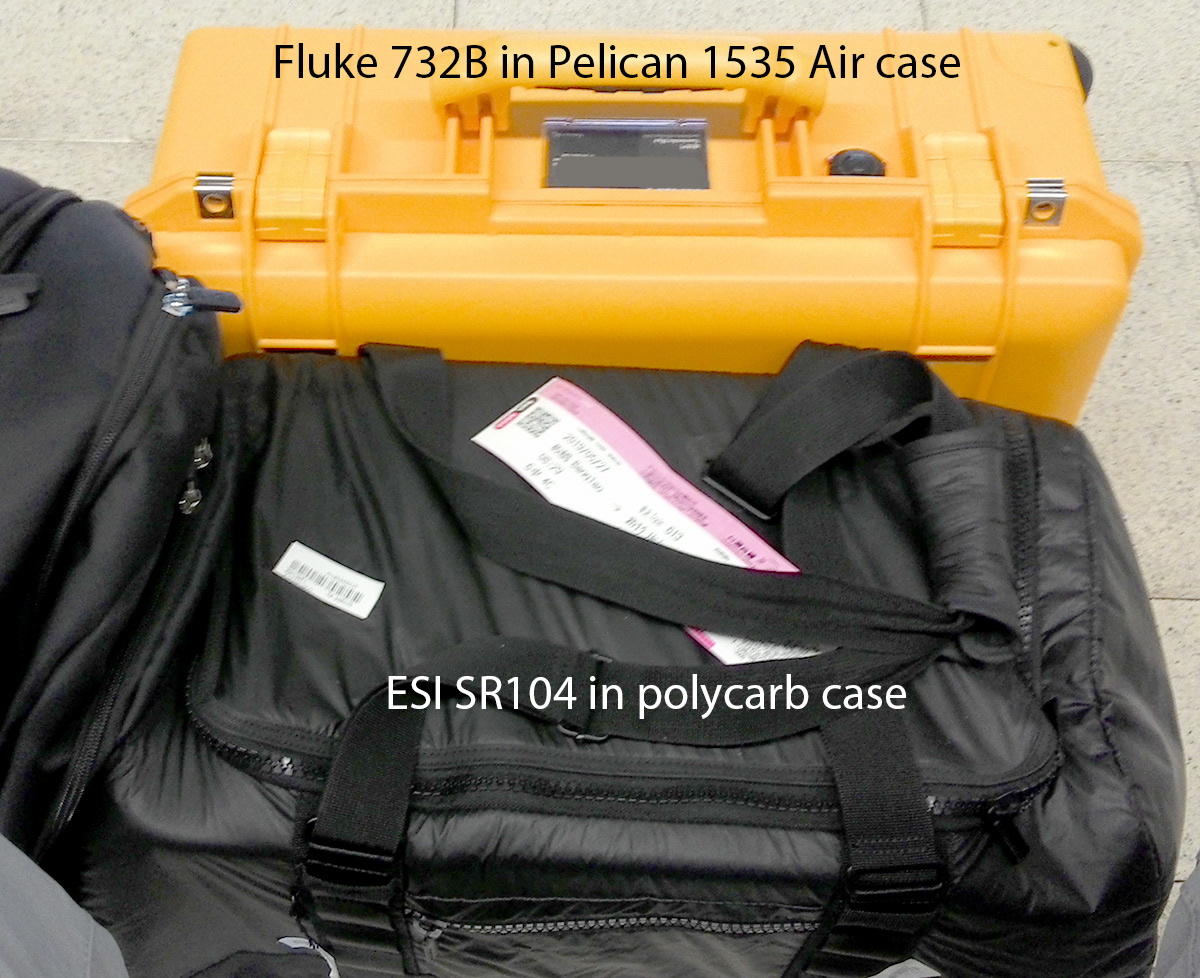
I didn't have proper case for ESI SR104 in time

Standards such as Fluke 732B or ESI SR104 are reasonably robust, but it is still preferable to hand-carry fragile devices to and from the calibration facility in order to minimize possible stress and changes in output voltage/resistance. Fluke 732B was kept hot on battery backup power during transit, reconnected shortly to the AC power line to recharge upon arrival to the measurement lab. DC standard was floated on battery power again during the measurement cycle with PJVS system to avoid common-mode noise pickup from the mains power line.
Upon my arrival we proceed with a short tour, covering three main electrical laboratories.
DC Voltage LaboratoryPrimary voltage standards at CMS are using Josephson effect in superconducting junctions cooled to -269 °C and secondary standards are usual room-temperature solid-state zener devices, in shape of commercial units like Fluke 732A/B and alike. Zener stability at long term is in the order of 1-5 µV/V (or 0.1-0.5 ppm for 10V output) per year.
SI Volt at CMS is provided by
NIST SRI 6000q PJVS. This PJVS can generate stable, quantum-accurate, DC voltages, programmable in the range from -10 volts to +10 volts.
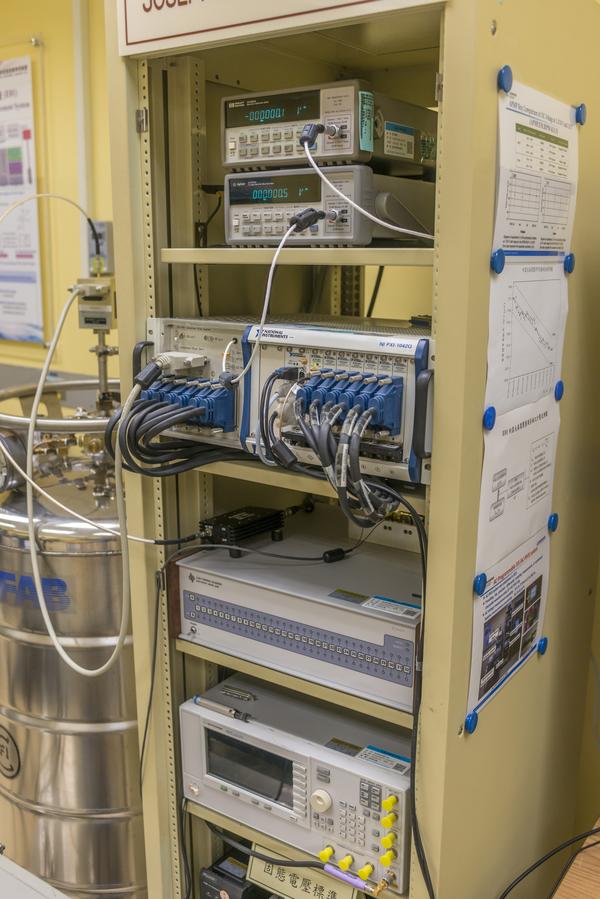
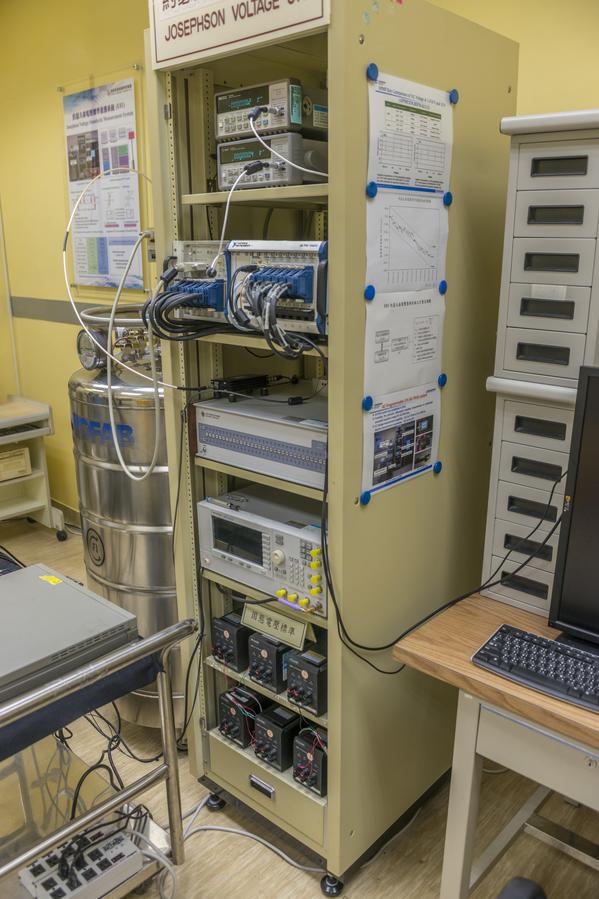
The quantum accuracy of these voltages is derived from the Josephson Effect such that every superconducting Josephson junction in the PJVS circuit produces a voltage precisely proportional to the frequency of the applied microwave bias signal. CMS engineer was kind enough to show me dead NIST PJVS chip for pretty photo.

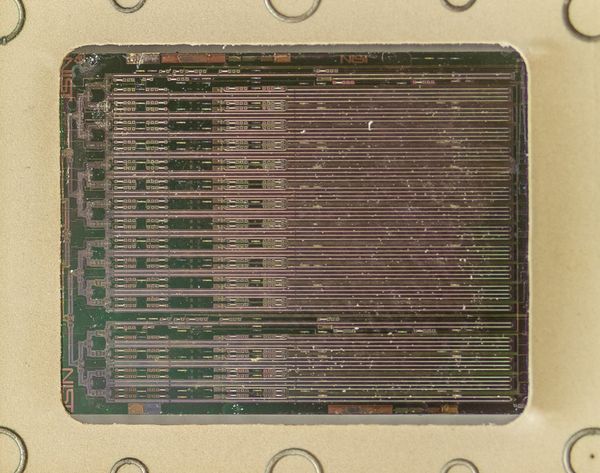
Here's break down of the system components:
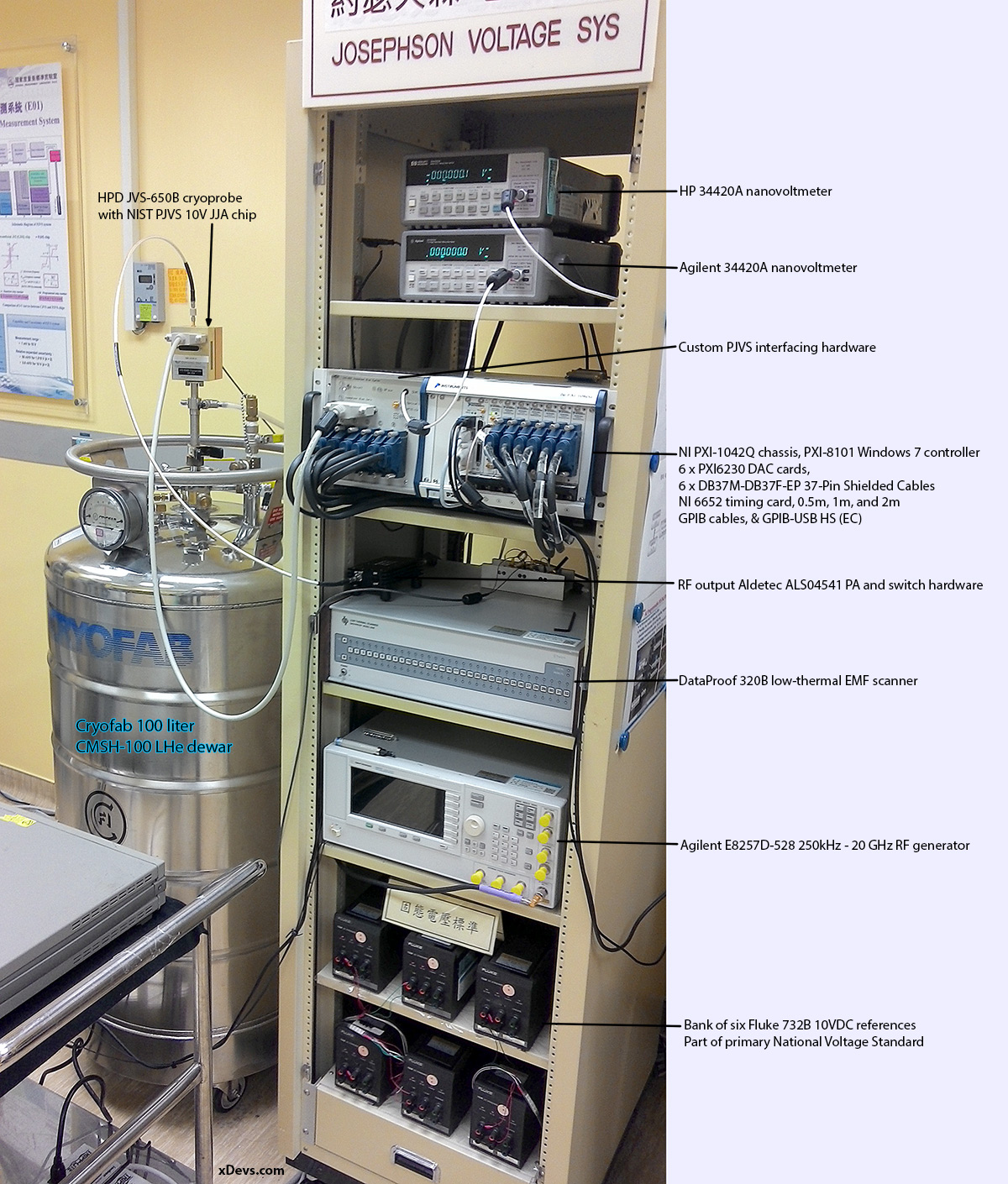
Nearly all hardware is commercially available. The only special parts are cryoprobe with NIST superconducting chip with Josephson array, RF microwave amplifier, bias interface and NIST control software. This makes system expensive, but serviceable in short time if RF source, detector or PXI module develop a failure. Because Niobium junctions on Josephson Array chip can become superconductive only at a temperature below 5K (-268.15 °C) Liquid Helium is required to provide cooling. That is what large 100-liter tank from Cryofab contain when the system is in active operation. That amount of helium is evaporated by a period of three weeks, resulting hefty price to keep in JVS apparatus in operation. Many labs do not keep JVS operating all the time, but only use them on cycle periods during few months to perform calibrations and transfers of quantum Volt to solid-state reference array.
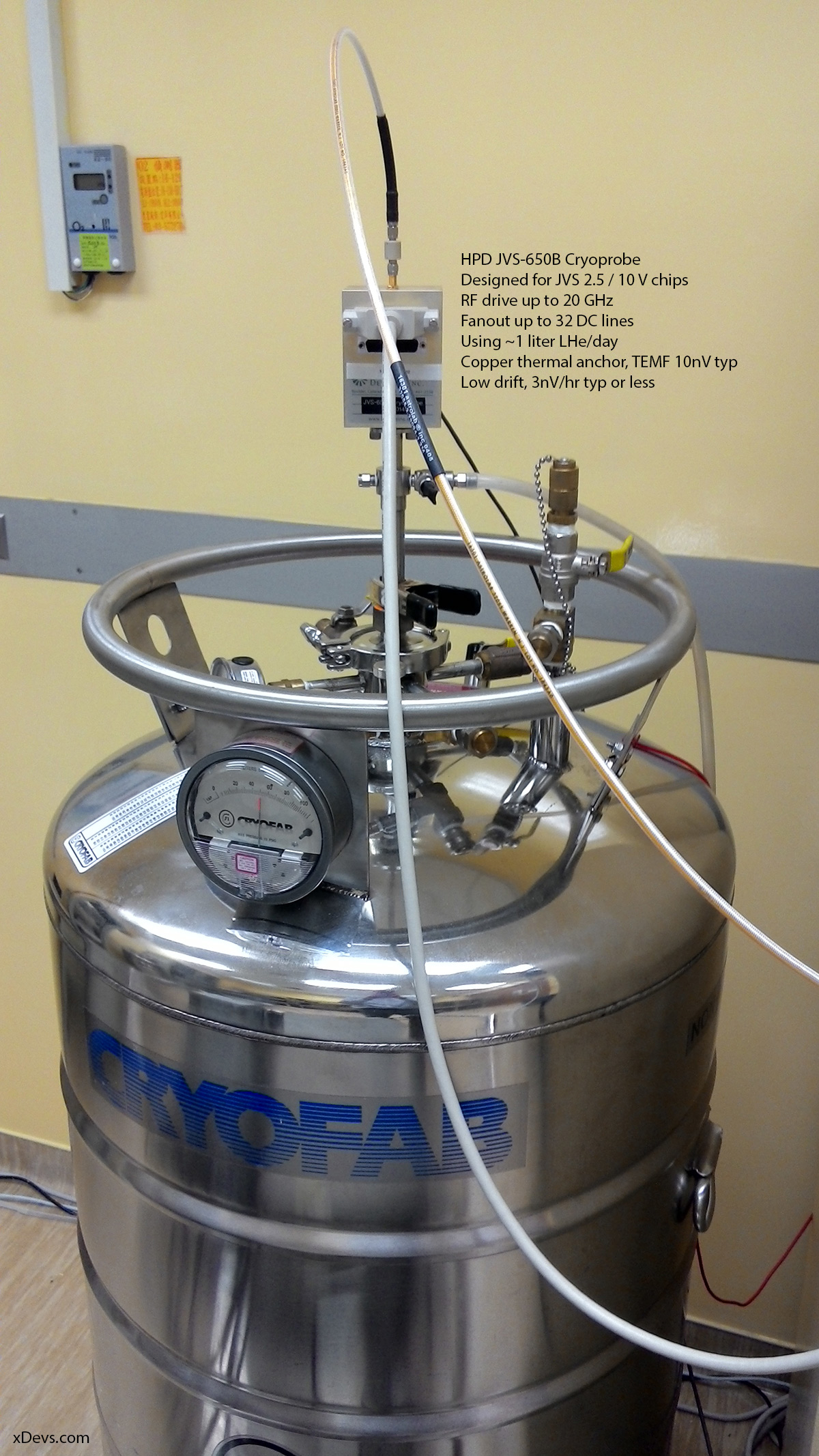
As the system operates, helium vapor vents through a gas valve for further recovery. This valve visible on the cryoprobe top flange with tube back to lab’s helium recycle system. Helium recycle is an important factor, because this light gas is a limited non-renewable resource on Earth and must be preserved. Earth atmosphere cannot prevent such light and inert helium gas from leaking into space.
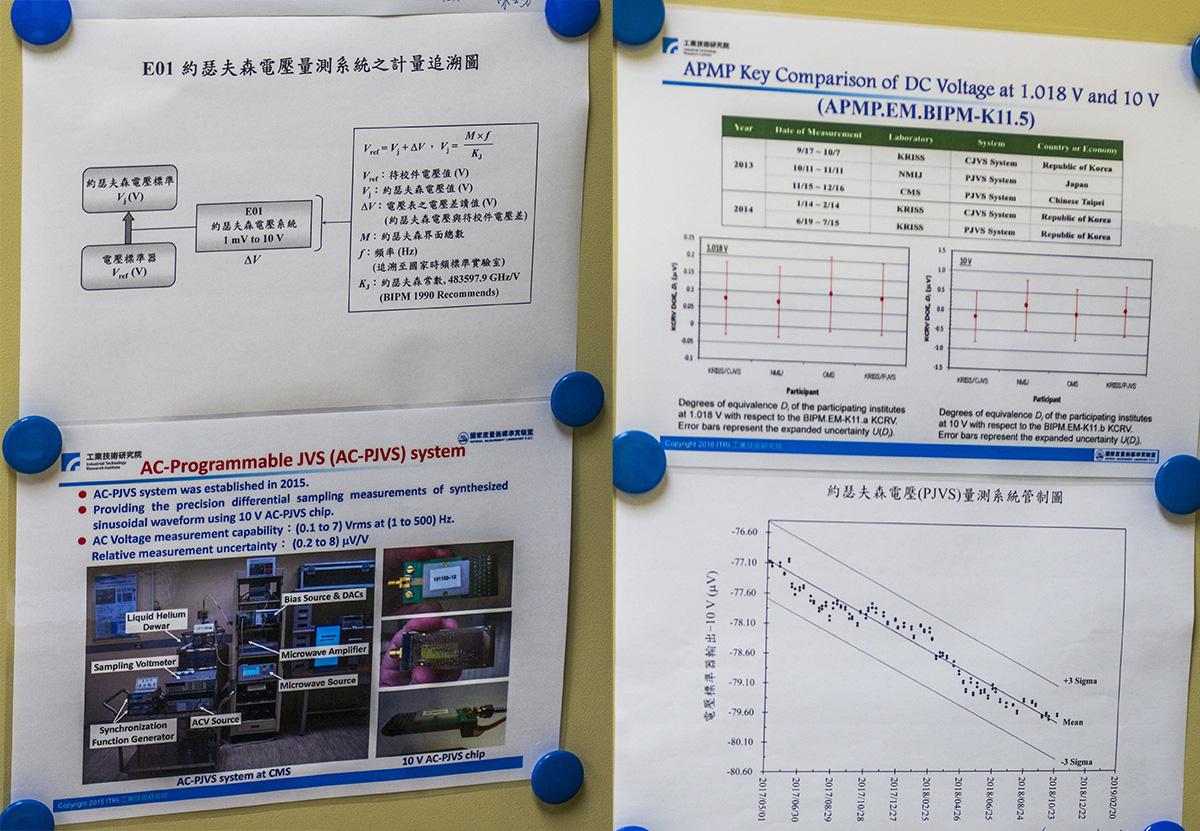
Taiwan’s National Volt also use secondary solid-state reference ensemble, in form of six stand-alone Fluke 732B. Three of them were specially modified by Fluke to provide cardinal point 1.0000 VDC instead of standard 1.018 VDC. 1.018638 V level was used back in the days before 1990. This voltage was the output of the Weston-type chemical cells, that used provided International Standard for EMF from 1911 till retirement from Josephson systems in 1990.
Weston cells are still used today in metrology, despite being very fragile, incapable to sustain any current draw and difficult to maintain. Weston Cells also imply significant HazMat risk, due to a significant amount of cadmium, mercury, and related toxic chemicals. The groups of well-maintained Weston Standard Cells highly stable over time otherwise, but they are more often replaced with zener diode solid-state DC voltage standards, which are more robust and convenient to use. The output of solid-state reference, however, drifts with time and is also subject to environmental conditions changes like ambient temperature, relative humidity, and pressure. To obtain the best accuracy it is necessary to construct a mathematical model of the particular reference device to predict its output voltage at any given time and under given environmental conditions.
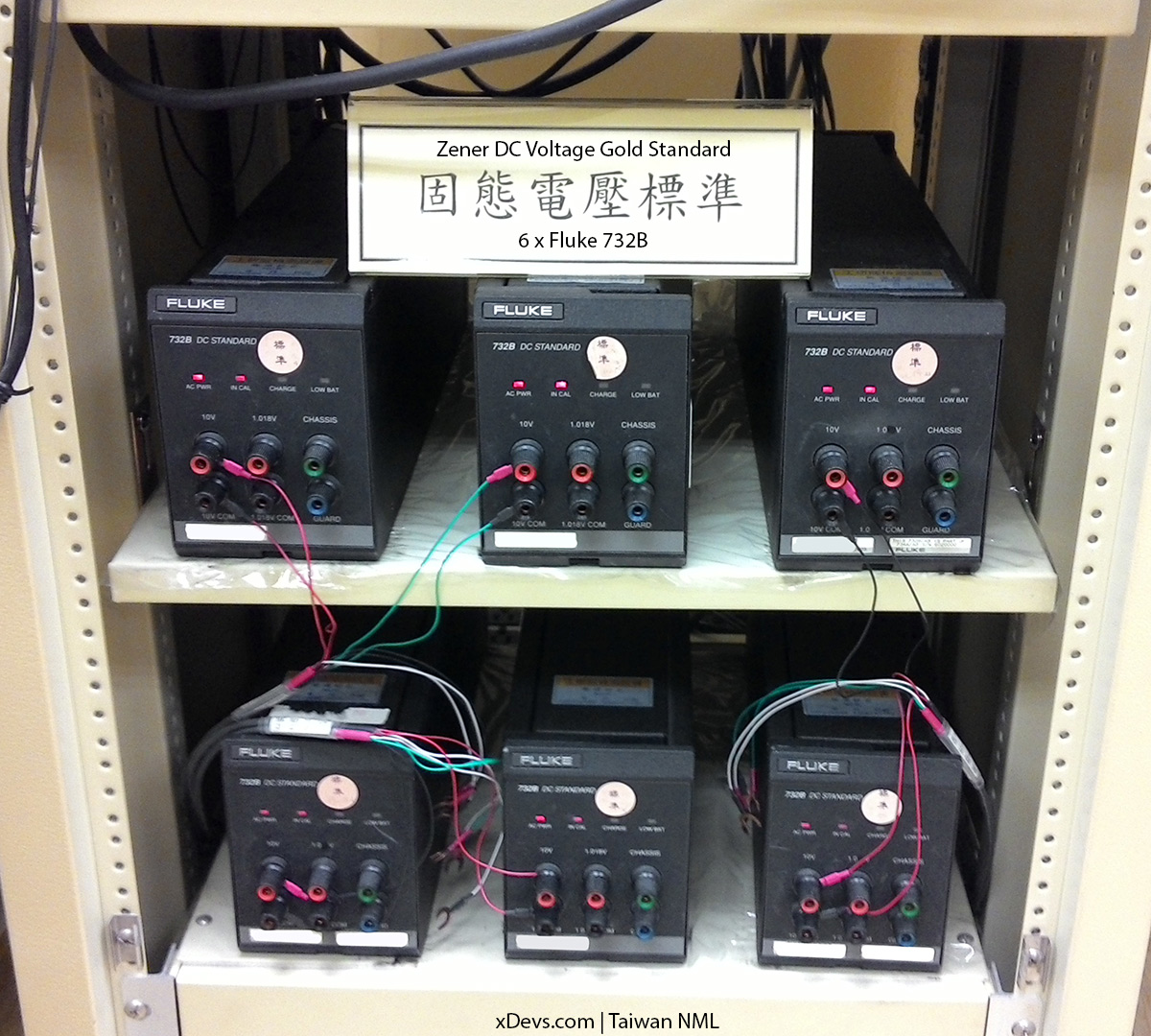
Commercial solid-state references are based on only one high quality selected zener devices such as Linear LTZ1000/LTZ1000A, Linear LTFLU-1 or older Motorola SZA263. Use of since chip making it impossible to detect any variation of this critical component without external stable and known reference.
Most labs as a result use multiple units of solid-state references, to form a multi-device bank for reducing the variation of the averaged “Lab’s Volt”, and to detect variations between individual devices. Such a system, when monitored periodically can also help to detect damaged units which may have excessive drift or sudden output voltage jumps. xDevs.com labs also follow this idea, and we use both multiple solid-state zener devices to keep “xDevs.com Volt” together with multiple detectors (Keysight 3458A and Keithley 2002). Adding meters into the validation loop also helps to cover the stability of LTZ1000 references used in these high-end DMMs.
CMS can calibrate long-scale multimeters, calibrators and dividers, for which they use set of equipment we are already familiar with in metrology section here at EEVBlog.
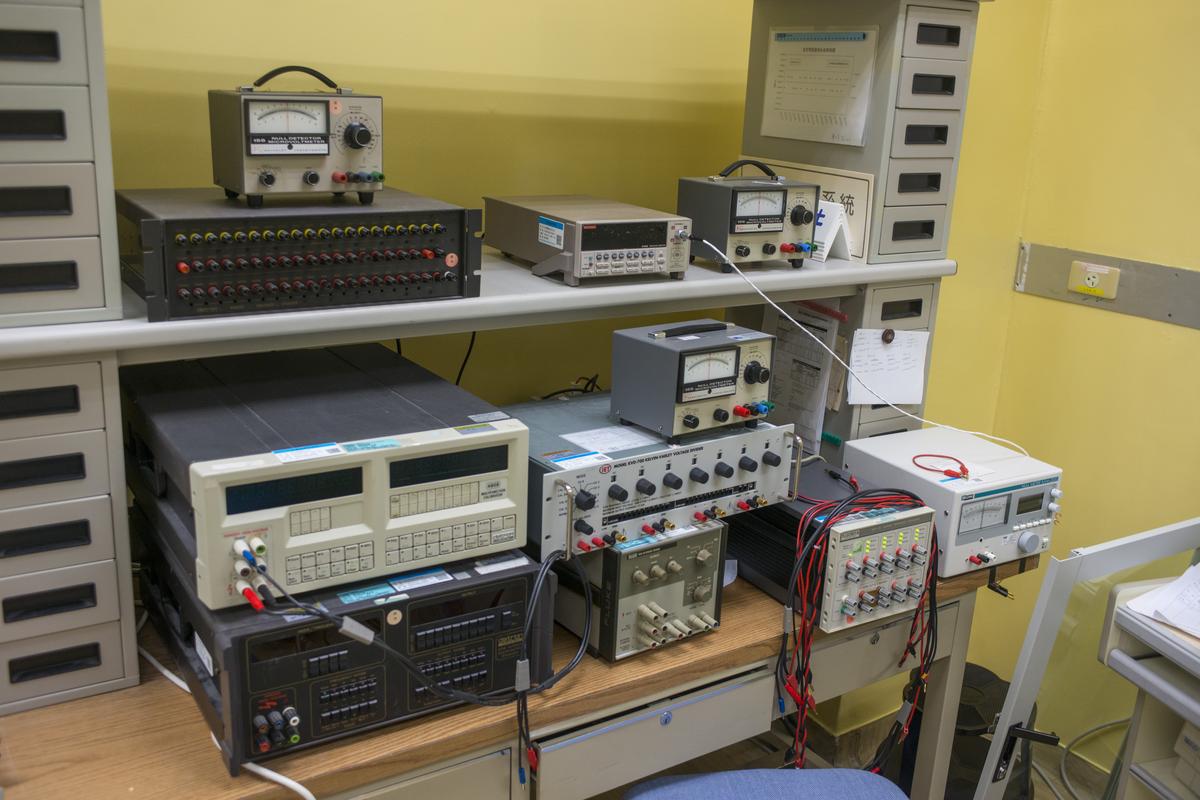
Set of dividers and high-end calibrators are used for E04 service, when customers need calibration of their dividers or measurement/source instruments, such as calibrators, DMMs or sources. We can see good old Datron 4708, Datron 4808, set of very nice Keithley 155 null-meters, special and rare Datron 4902S filled with hundreds of metal foil VHP resistors, IET KVD-700 0.1 ppm manual divider. There is also Fluke 752A reference divider, Datron 4910 with 4 LTZ1000A-based cells and Keithley 2182A nanovoltmeter. Lab is currently testing new binary voltage divider, manufactured by Measurements International, Model 8000B that replaced Fluke 720A.
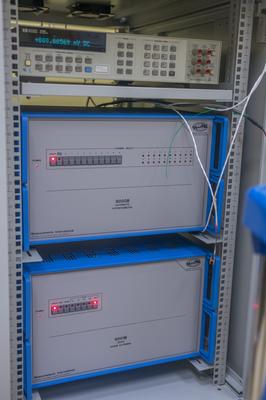
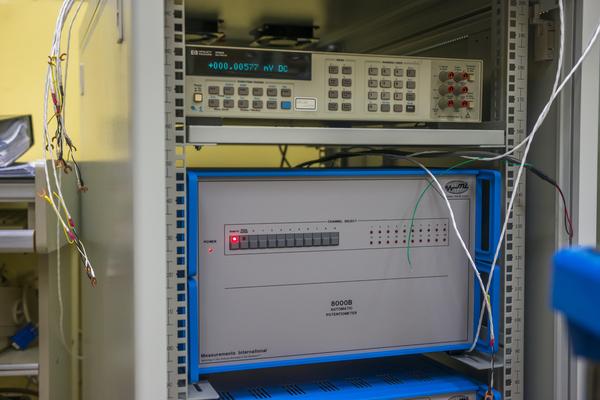 Resistance Laboratory
Resistance LaboratoryResistance Standard lab is just across the hall, in close proximity. This lab is literally filled with expensive Measurements International equipment and all kind of resistance gizmos.

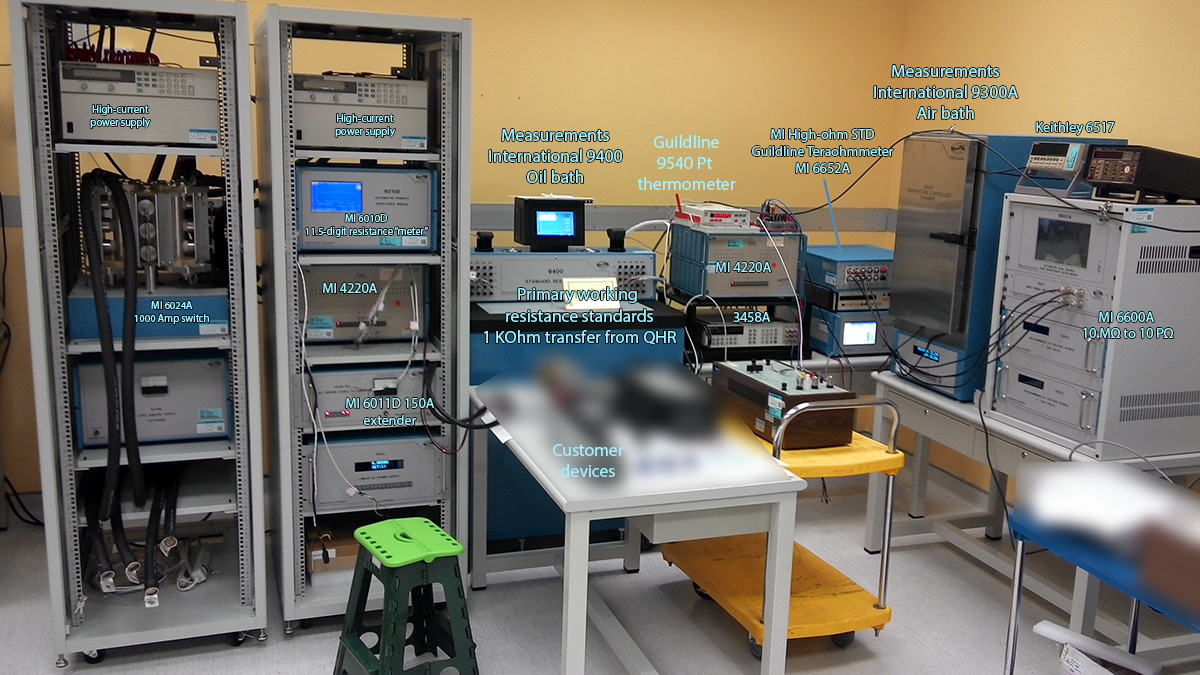
And Quantum Hall Effect resistance standard in it's glory. SI Ohm Primary reference realized by cryocooled Quantum Hall Effect system. This system can provide and maintain quantum-accurate resistance 12906.4037296… Ω if used with i = 2 steps. Traceability obtained with QHR chip from PTB lab, but ITRI CMS also manufacture and test their own in-house designed QHR chips. Uncertainty of this resistance output is about 0.06 ppm, due to thermal and parasitic effects.
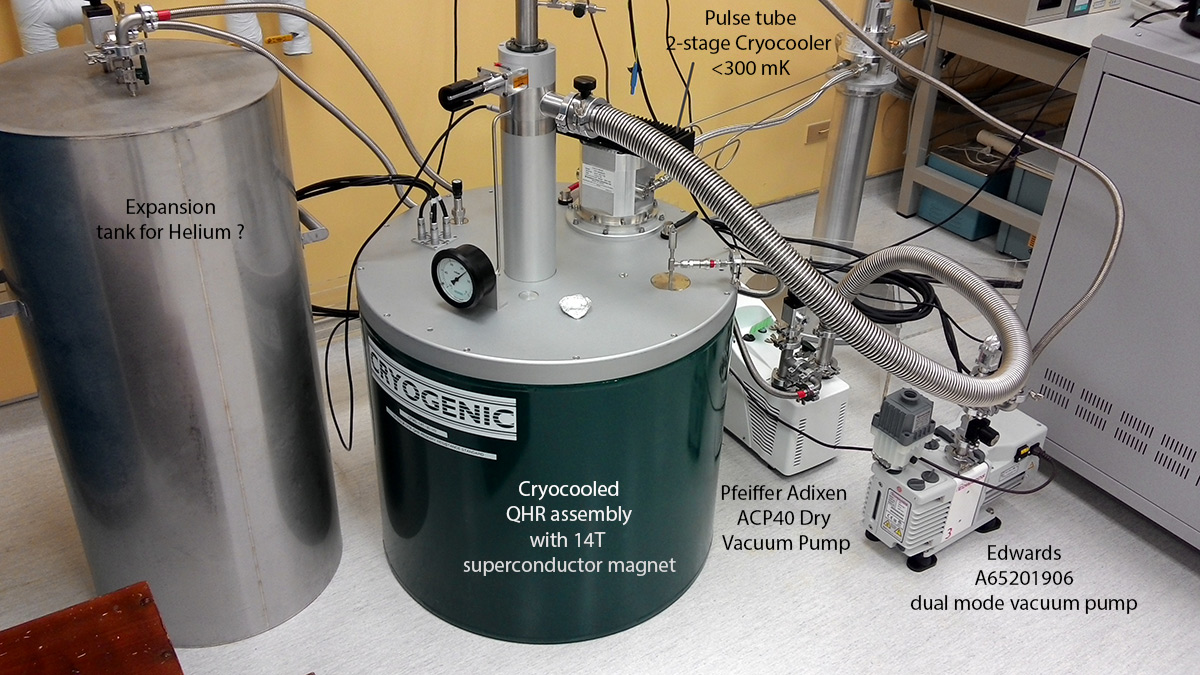
Primary resistance is realized by closed-loop helium-cooled apparatus and GaAs QHR chip from PTB. Just like JVS, Quantum Hall effects occurs only at very low temperatures below -270 °C and in strong magnetic fields. Corresponding vacuum-sealed cryogenic system and a superconducting solenoid are required for QHR operation. GaAs heterostructures became the established material at a temperature below 1.5 K and in a magnetic field of typically 10 T.
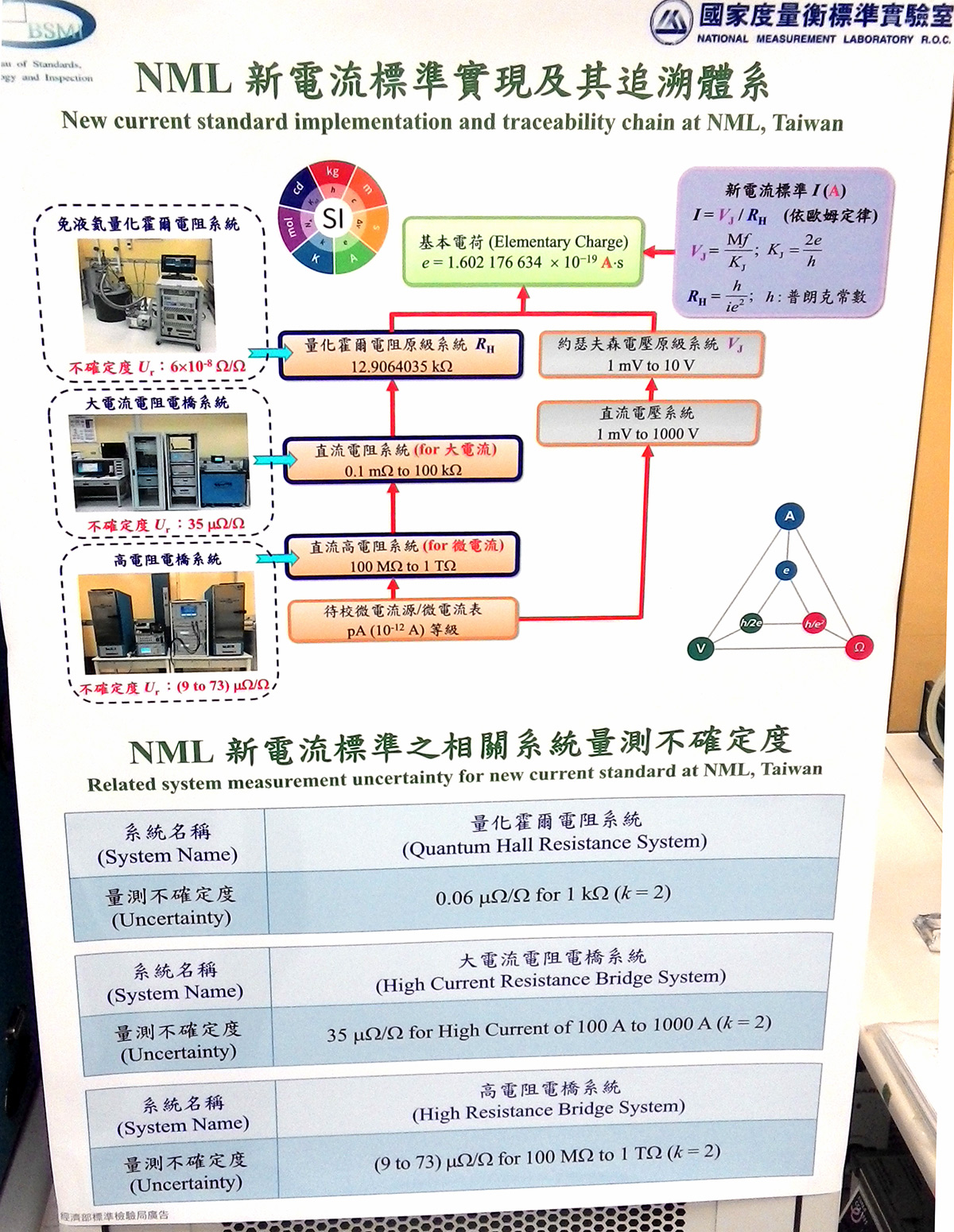
ITRI CMS also manufacture and test their own QHR devices for other labs and NMLs.
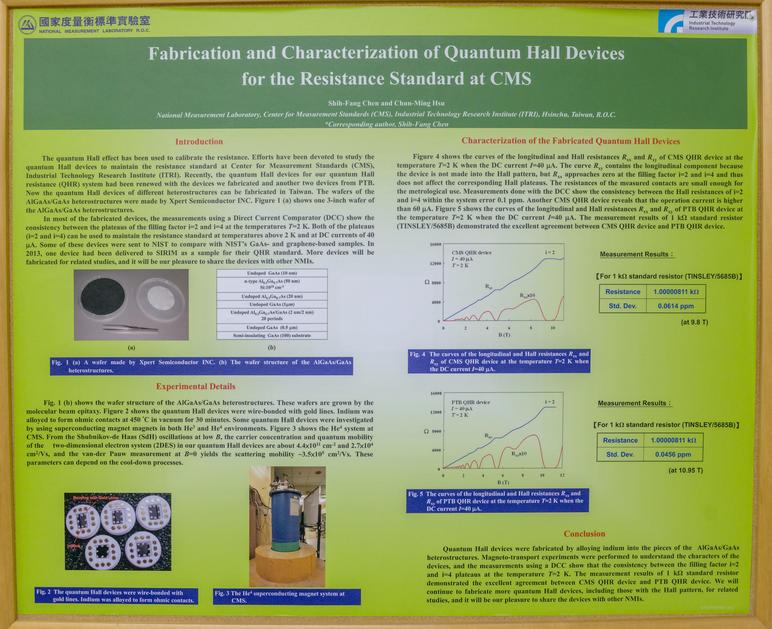
And because I had visit right after new SI 2019 redefintion applied in May, QHR system was running and I captured some cryocooler temperatures on the monitoring equipment. Intermediate stages in QHR chamber are cooled to ~54K and 4.7K. While this cooling system does not require refills for liquid helium tank, it consumes a lot of electrical power (~7 kW from 3-phase mains) to enable such low temperatures for 24/7 operation.
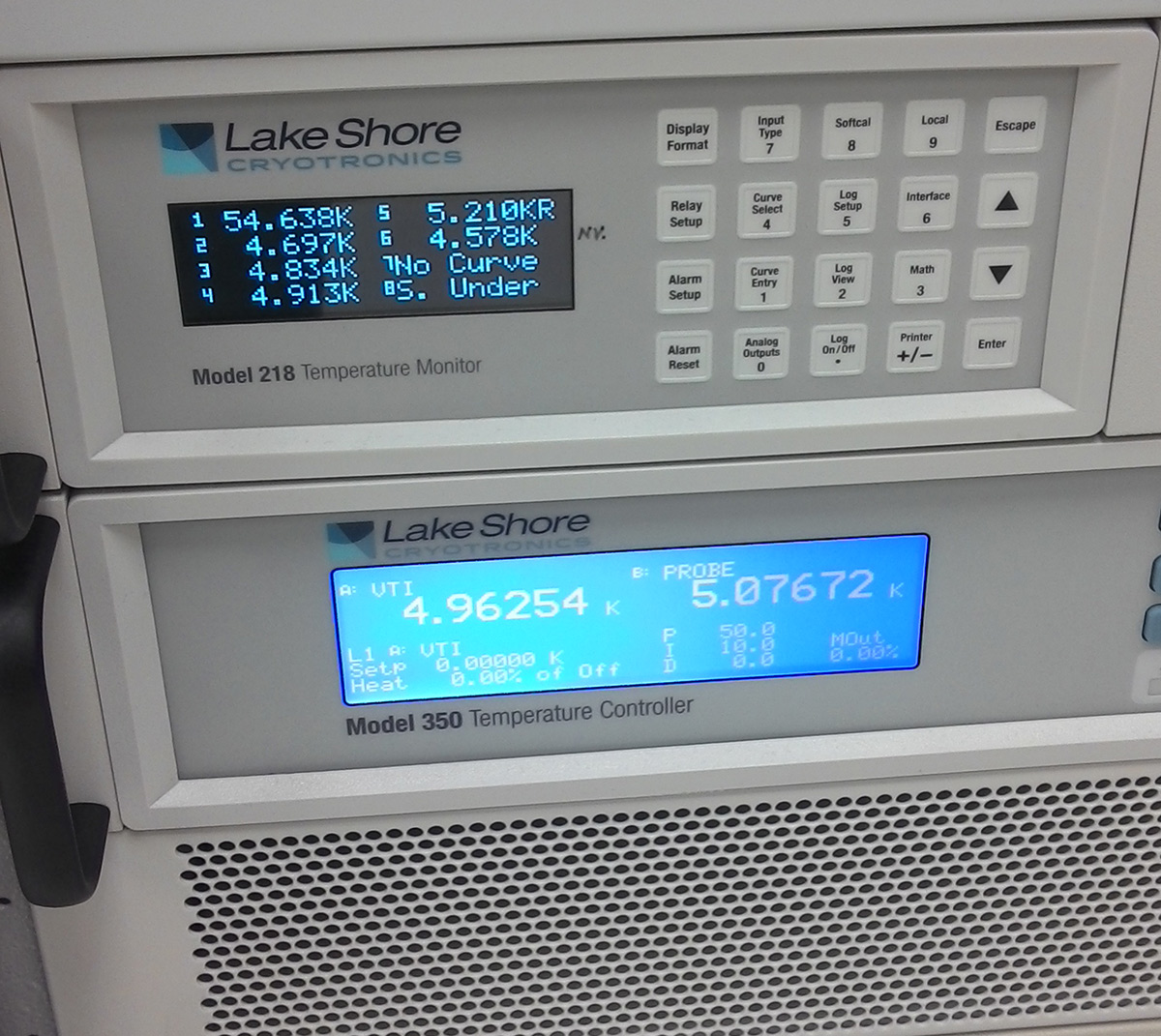
Unlike JVS setup, this Quantum Resistance cannot be programmed to arbitrary values, so external very high resolution ratiometric measurements are performed with help of DCC rack. First resistance is transferred to cardinal point ultra-stable wire-wound resistors, manufactured by Tinsley, MI, Guildline.
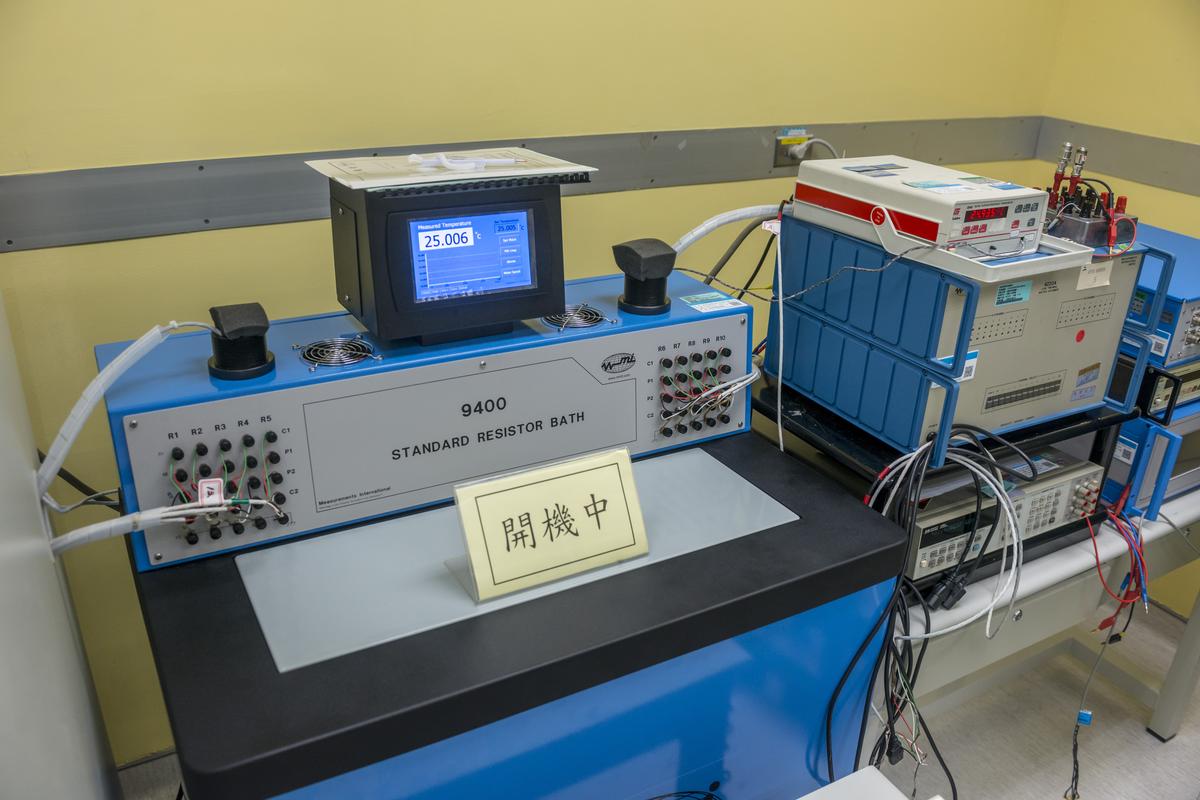
Taiwanese National Ohm resistance set sits in Measurements International 9400 Oil bath thermally controlled tank. This bath maintains 75 liters of oil at constant +25°C temperature with stability <0.002 °C. The temperature in the bath can be programmed by the GPIB/RS232 interface. This unit can cool or heat oil in the bath using Peltier elements.
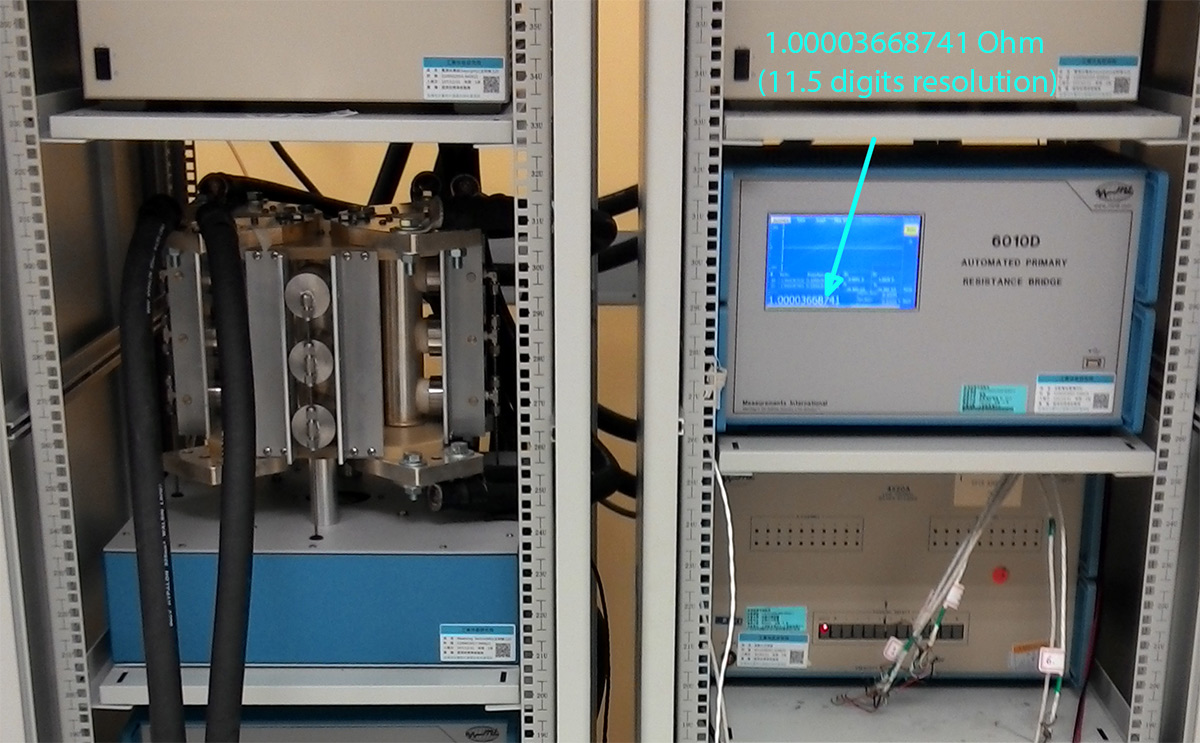
High current switch and current sources used to measure high-power shunts used in applications like industrial power meters, high-power experiments, battery, and power supply design and energy conversion industry.
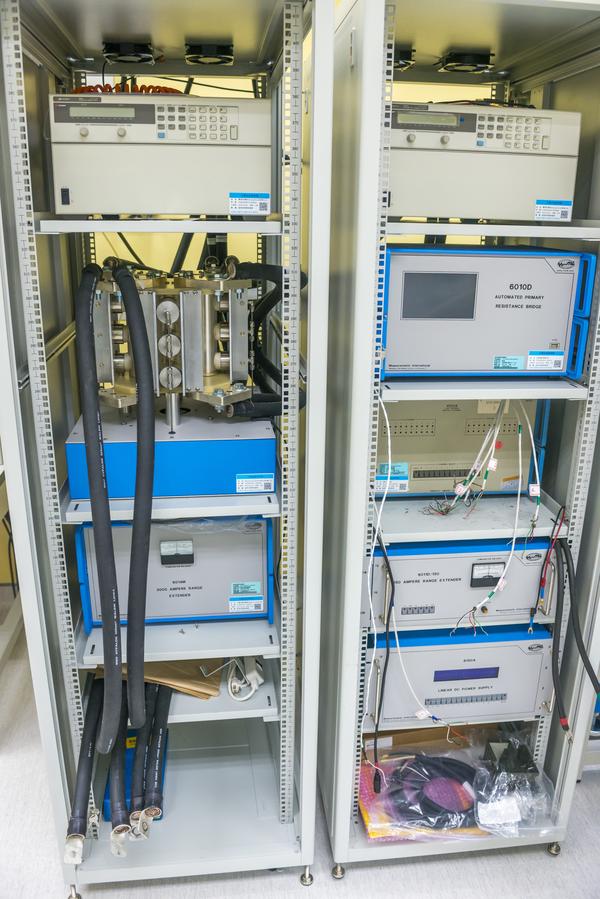
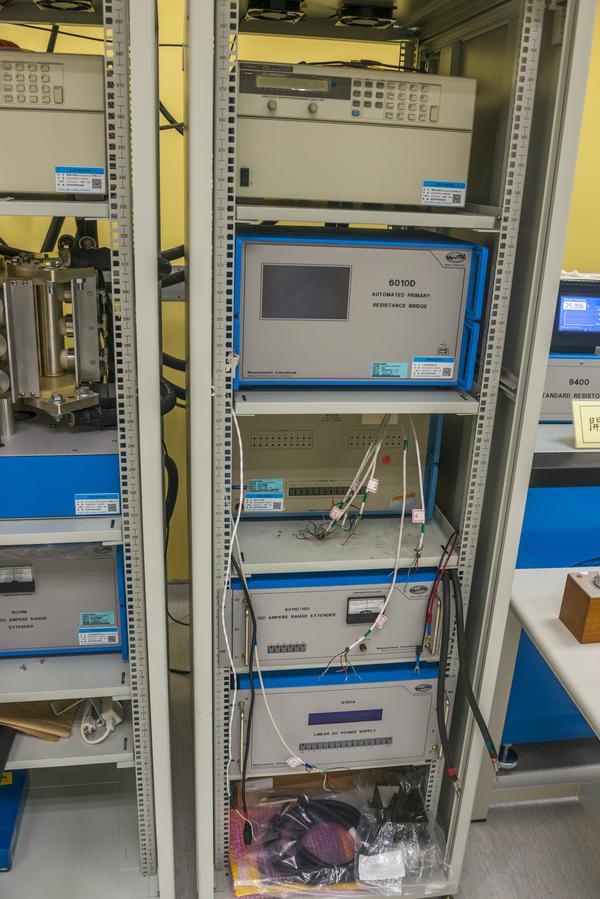
Typically high-accuracy resistance measurements use direct current comparator bridges, such as Measurements International 6010. Here we have latest version 6010D, able to perform ratiometric resistance transfers with resolution up to 11½ digits for resistances 0.001 Ω to 100 KΩ. Bridge have accuracy specification better than 0.04 ppm on 1:1 or 10:1 ratios, and linearity better than 0.005 ppm.
Bridge is configured in tall 42U 19-inch rack with 4220A Low thermal matrix scanner + MI 6011D (150 amp) + 6014M (3000 amp) current extenders. MI 4220A scanner allows automatic switching between different standard resistors to cover all resistance ranges in an automated manner, which is useful for multi-resistance standards calibration or MFC verification. Scanner has 20 4-wire low thermal inputs using tellurium copper contacts and terminals with two 4-wire outputs. All switching relays are hermetically sealed and support 250 Volts or 4A of current. Thermal EMF error contributed by the switch is specified less than 20 nV, while insulation resistance is in excess 1014 Ω.
High DC current sourced by not one, but two Keysight 6680A 5000 Watt power supplies. Each of these beasts can source up to 875 Amp. Interesting enough, Keysight discontinued these PSUs, with no alternative offering for such high currents on site?
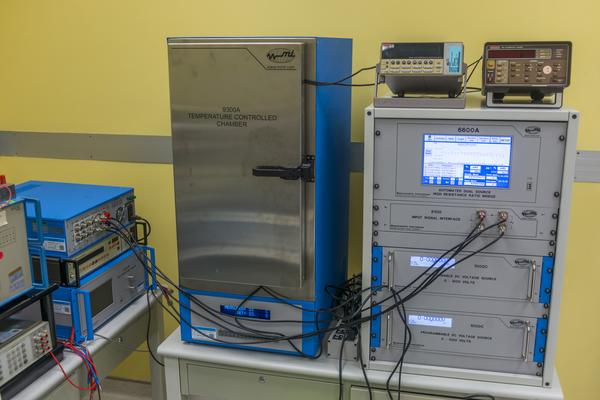
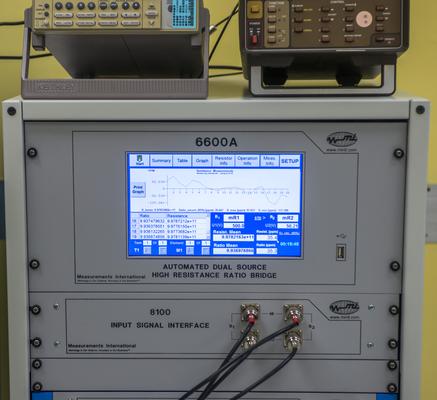 AC Voltage/Current Laboratory
AC Voltage/Current Laboratory
To maintain low-frequency precision AC voltage and current calibrations CMS using a set of characterized thermal converters, coaxial Fluke A40B shunts, Fluke 792A AC/DC transfer standard, and calibrators.
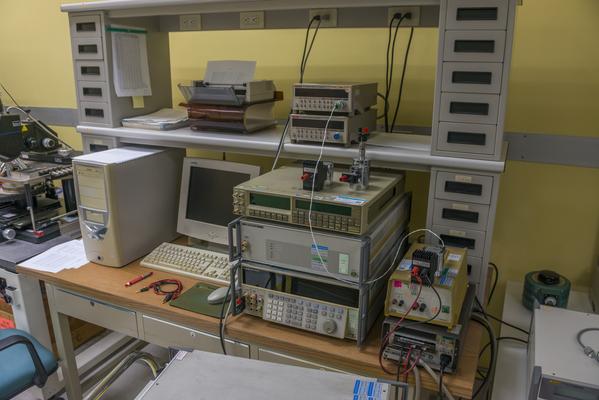
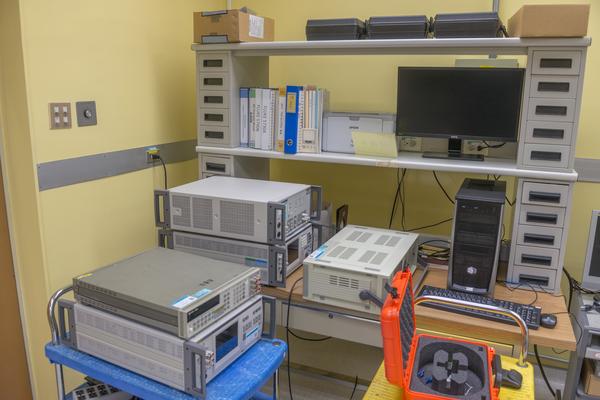
In AC lab we can see Fluke 5790B AC/DC transfer standard recently released in 2016, Fluke 5730A high-end multi-function calibrator, together with Fluke 52120A high-current trans-impedance amplifier.
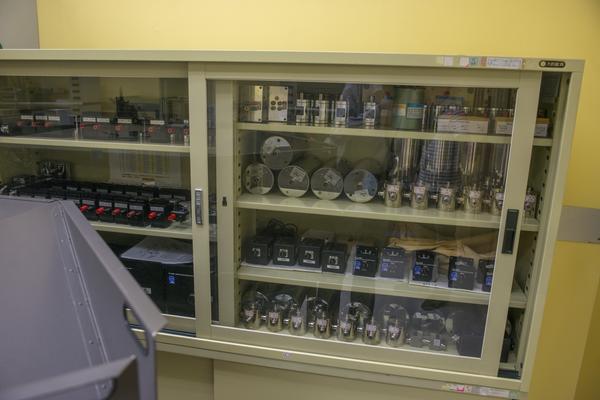
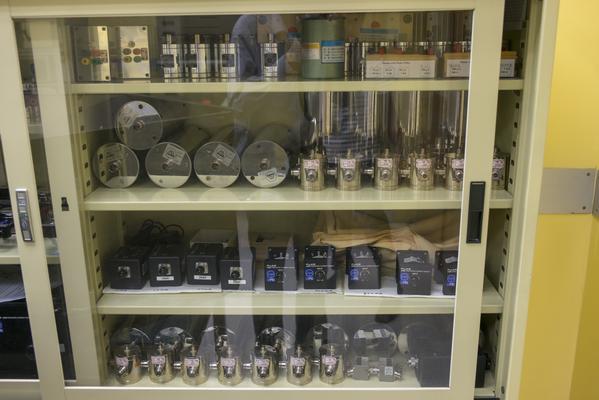 Calibration results
Calibration resultsITRI CMS Lab is approved and certified by BIPM via participation in key comparisons. This is public information, published on
BIPM site.
BIPM Record from KCDB, ITRI CMS expanded uncertainties for electricity, November 2016On arrival to the CMS, both standards were inspected to confirm safe transport, and Fluke 732B was plugged to mains power to maintain battery charge. A few hours later short test was performed, taking a measurement on automated solid-state zener bank measurement system, to confirm good and stable 10V DC output from our 732B. The unit left to settle after transport stress for 4 days, and calibration versus Josephson Voltage System has performed afterward on May 31, 2019. DC Standard was operated on battery power during the measurement.
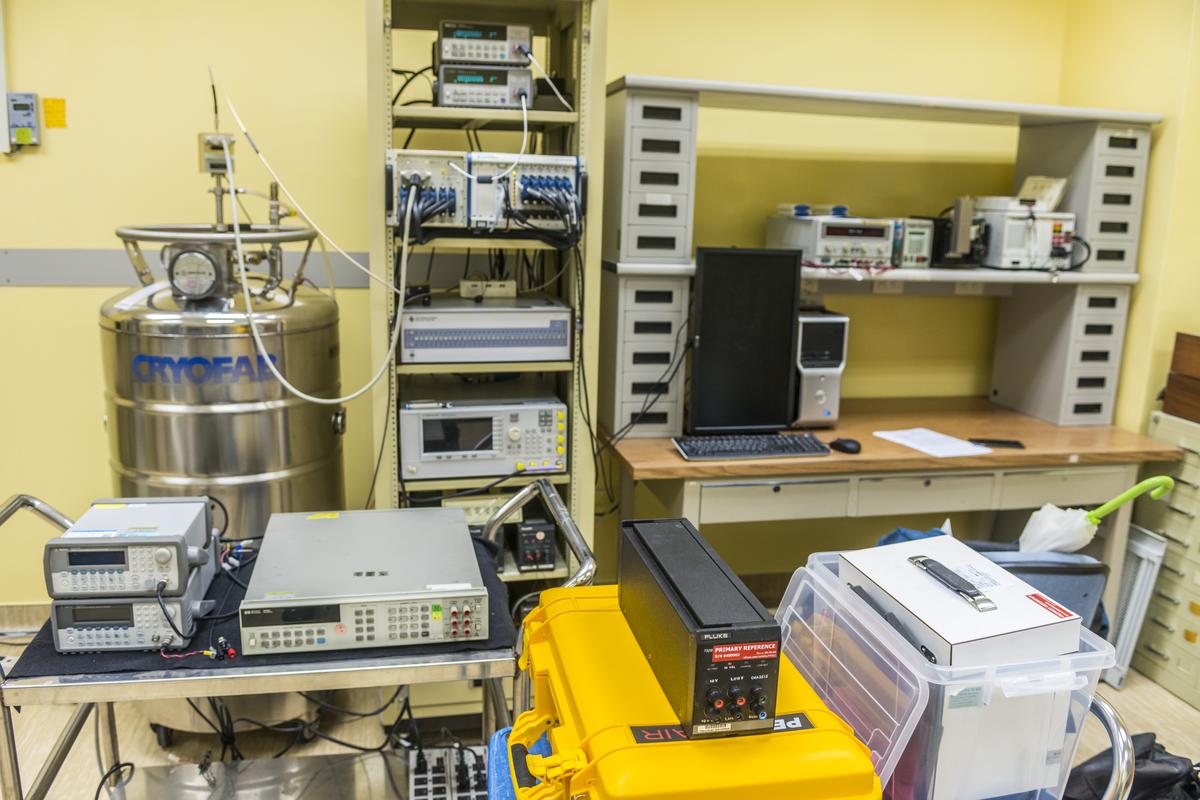
Calibration report expanded uncertainty for our DC standard is tiny 0.02 µV/V, which translates into 0.02 ppm at 10 VDC output level. This is so small, that standard essentially will drift outside of this uncertainty just in term of a few days. If we take Fluke’s specification for 90 days, maximum drift is listed at ± 0.8 ppm. Uncertainty valid period estimation on this worst-case scenario can be roughly done by box method:
Drift 0.8 ppm / 90 days = 0.008888… ppm per day. UCAL_JVS0.02 ppm / 0.0008888… = 2.25 days
Even if particular 732B is 10 times better than its specification, that would still make own 732B surpass uncertainty of the direct calibration against JVS in less than a month.
So paying extra for JVS calibration on solid-state standards is a waste of money? Well, not so simple. If we perform multiple calibrations over the longer time span, all with this level of uncertainty, for example, every month during a year, it would be possible to build actual DC output prediction statistics model, and future calibrations would be done to maintain that VPREDICTED with good uncertainty. All solid-state references drift, but that drift usually stays constant in magnitude when the standard is undisturbed by external influence and power. This way we can “override” specifications provided by Fluke and use our own data to obtain sub-ppm accuracy over longer time span. In fact, Fluke even has a
public white paper touching on this subject.
NML Calibration report for xDevs.com's Fluke 732B DC Voltage StandardNML Calibration report for xDevs.com's ESI SR104 Resistance StandardNML Calibration report for xDevs.com's Fluke SL935 Heated Resistance Standard (both outputs, 1 Ohm and 10000 Ohm)NML Calibration report for xDevs.com's 792X DC Voltage Standard "FX" LTZ1000A 10V outputESI SR104 used for transfer allowed to soak at constant +23.000 °C air bath (Measurements International) for 4 days before actual measurement with DCC bridge (Measurements International 6010D) occur. Current used by the 6010D during measurement was set to 100 µA for 10 kΩ standard resistor in order to limit power coefficient and thermal heating effects. Because ESI SR104 is hermetically sealed resistor element in the oil bath, humidity is not considered as significant error factor.
Deviation of this particular SR104 is 0.0 ppm, according to lid note from June 2003 calibration, while actual certificate report from May 2016 reported 10000.0011 Ω measurement result, but the uncertainty of that reading is ± 1.0 ppm due to use Fluke 8508A-001 and other ESI SR104 as standard.
This calibration by ITRI CMS assigned resistance value 9999.9995 Ω with combined uncertainty just ±0.16 ppm. ESI SR104 standard was kept at constant temperature +23.000 °C in Measurement International 9400 air bath for multiple days before and during measurements.
Actual measurements were taken in a period of 4 days from June 3, 2019, till June 6, 2019, with MI 6010D DCC bridge system and primary national resistance standard with nominal 1000 Ω.
Because calibration took place during own CMS lab calibration cycle for all their primary resistors, QHR system was used to calibrate 1000 Ω standard at the same time, June 3, 2019. Even calibration report for our ESI SR104 is just 1 digit later to CMS’s own 1000 Ω. This means that error of DCC transfers between intrinsic primary standard like QHR system to 1000 Ω in the oil tank and followed by calibration our ESI SR104 10000 Ω is minimal, and most likely well below even 24-hour specifications of the MI 6010D system. As a result our SR104 received “golden” calibration, in some meaning, with uncertainty way below what is possible at even fully stuffed commercial calibration house.
Fellow metrology enthusiast
Lymex spent significant effort to collect data on many ESI SR104’s to estimate typical drift rate of these amazing resistance standards.
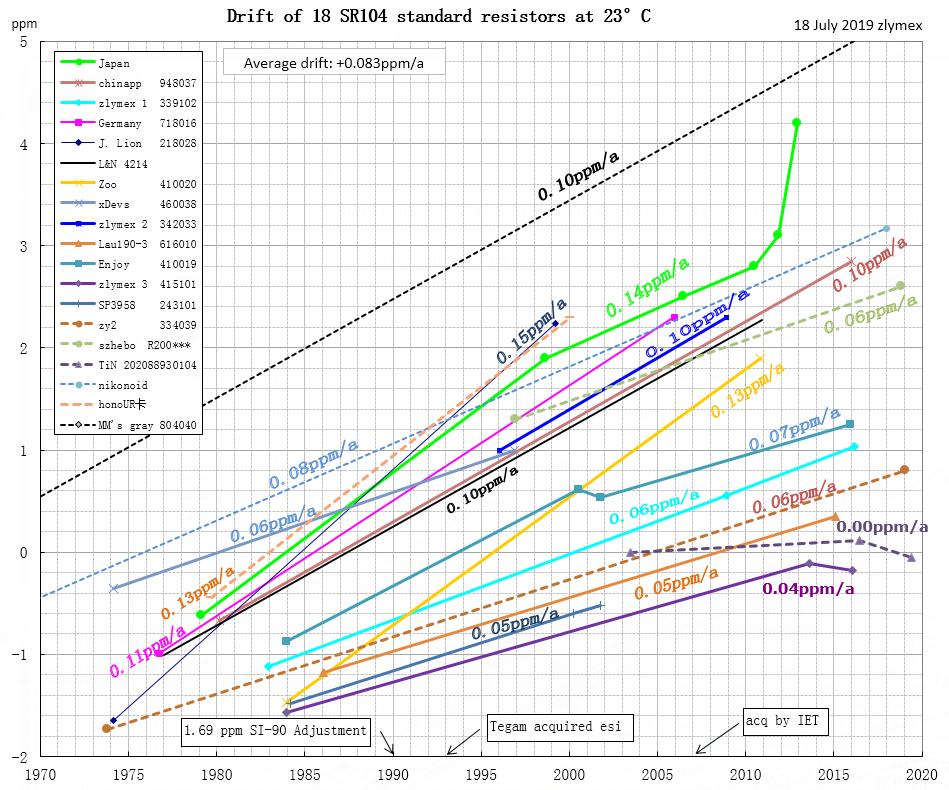
Based on his research, worst SR104 out of 17 units have drift just +0.15 ppm per year, which is far below any commercial resistance standard specification available. This again confirms the exceptional performance of these old ESI SR104 standards.
After standards received their calibration, I have hand-carried them back to xDevs TW lab and final question was “And now what?”. Next two chapters answer that in a moment.
Tests after calibrationI have captured calibration uncertainty of my two golden 3458A's based on traceable results in the past into the simple graph:
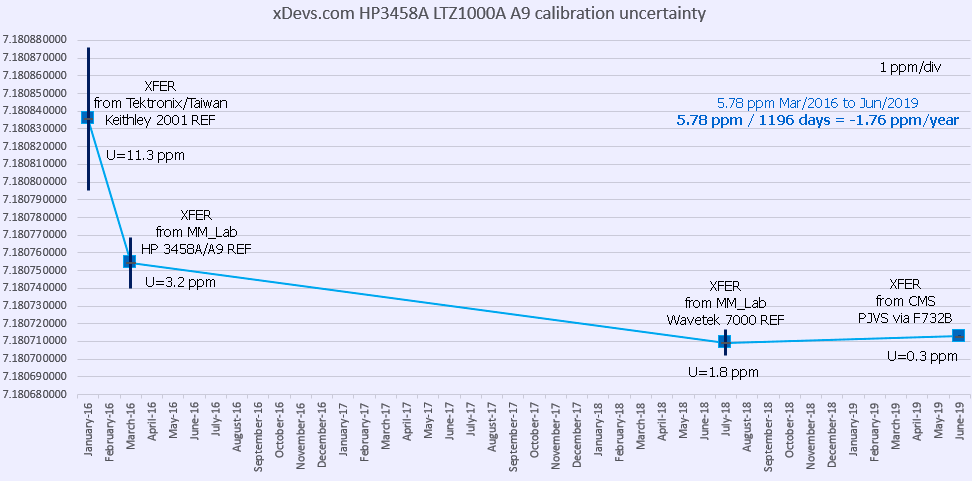
And for resistance, 40Kohm used in 3458A as internal standard:
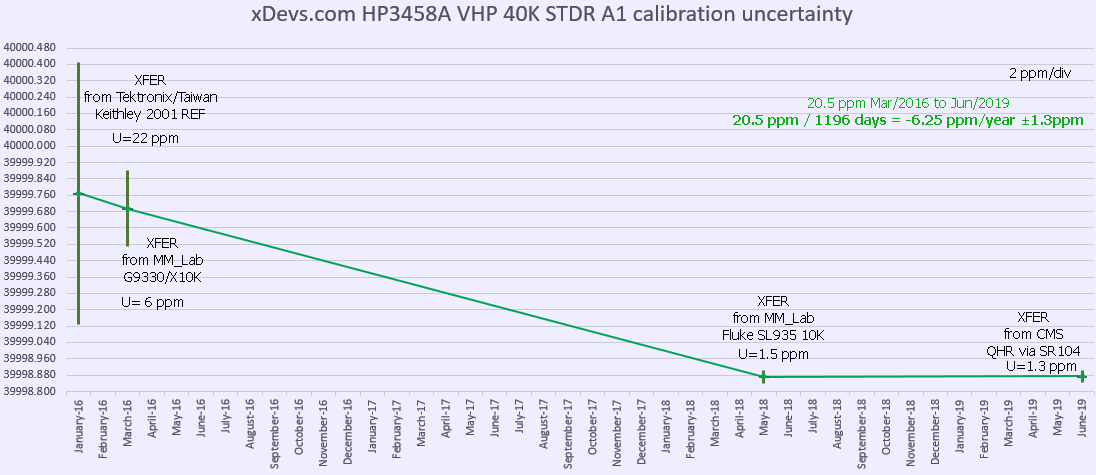
Also because we had done two traceable calibrations for SL935, back in 2017 and 2018 by Process Instruments, USA, we can take a look on how output changed, including possible shifts and stress induced by two international air-cargo transports of the standard (Taiwan - US - Taiwan).
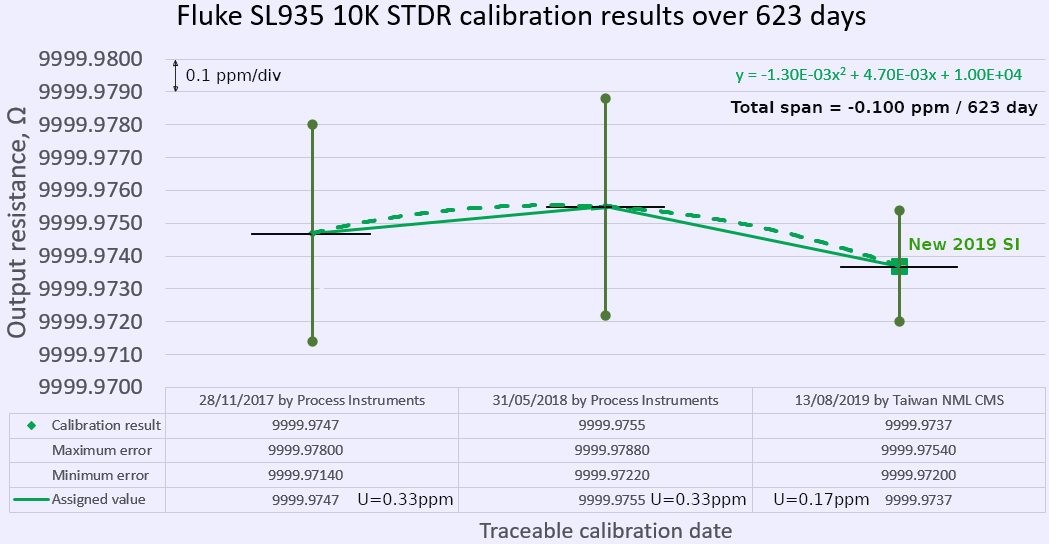
Change of -0.1 ppm over 632 days is
very impressive, especially considering that this is Fluke thin-film hermetic resistance technology standard, not wirewound standard made from voodoo materials with expert gray-beards. I'm very happy with this result.
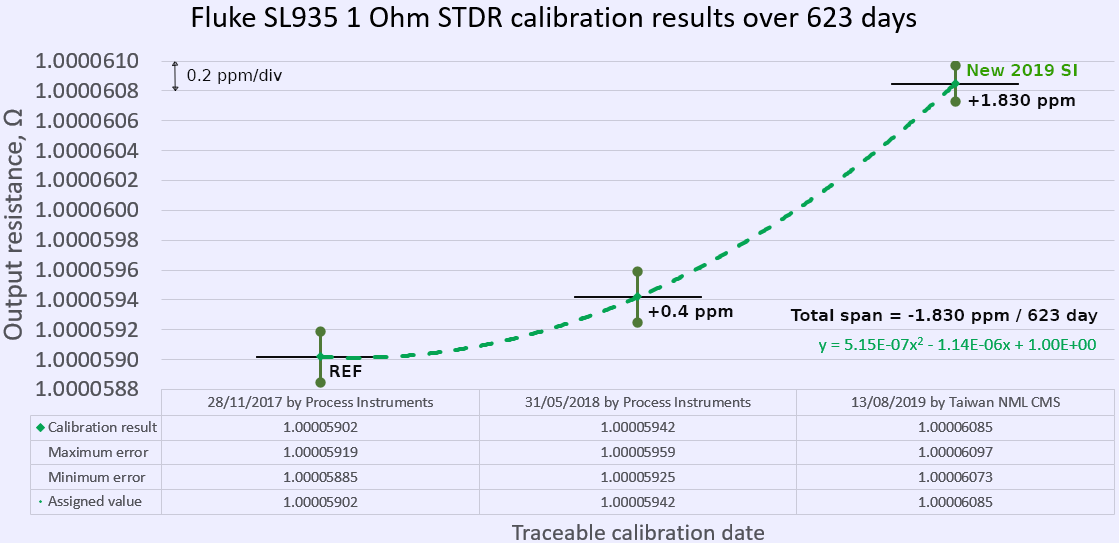
1 Ohm is also very good, but not as impressive. +1.83 ppm over 632 days is well enough to use as calibration standard for Fluke 5720A verification. After all this is what SL935 was designed for.
Transfer of the known +10V standard to DMMs such as 3458A or 5720A calibrator performed by executing routine calibration procedures, outlined in manufacturer’s service documentation. We keep logging of own DMMs LTZ1000A references and calibration constants, hence enabling the possibility to perform calibration adjustment of the instruments, without losing the history of the previous drift. Otherwise, adjustment of a precision instrument such as 8½ 3458A is not recommended, as this operation might easily bring a unit that was barely in specification well out of tolerance. 3458A's were adjusted to new Volt and logged for stability, while Keithley 2002, Fluke 8508A are kept with previous calibration constants. Datron 1281 DMM received few weeks ago, as the transfer meter from xDevs.com US Lab.
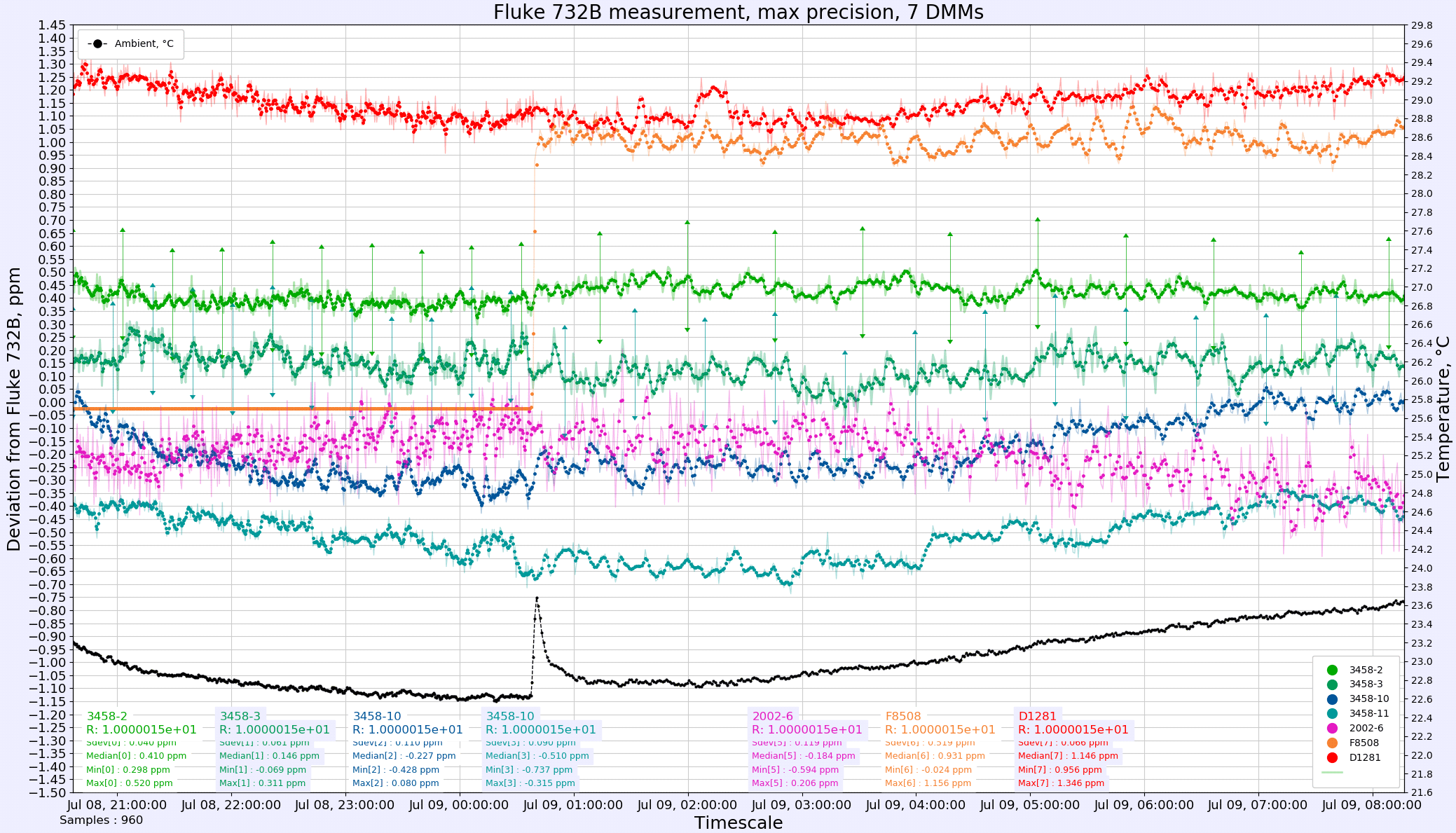 Artifact calibration verification of Keysight 3458A DMM tandem (4 meters) and Fluke 5720A calibrator
Artifact calibration verification of Keysight 3458A DMM tandem (4 meters) and Fluke 5720A calibratorFluke 5720A/03 calibrator and precision Keysight 3458A 8½-digit DMMs are the main workhorses in our lab for many measurements. It is important to maintain accuracy and stability. With help of freshly calibrated 10 V, 10 kΩ and 1 Ω standards and ultra-linear ADCs in 3458A we can verify correct operation of ACAL functionality, that is vital for these instruments self-calibration ability.
We use no less than four 3458A together to improve confidence in measurements. Two meters are in constant 24/7 operation since 2016, and they have hardware modifications to improve stability. These two “golden standard” meters able to demonstrate linearity agreement on main 12VDC range better than ±0.05ppm and temperature stability better than 0.05 ppm/°C (without using ACAL).
To verify calibration, automated xDevs.com calkit python app was used to run thru various points, using Fluke calibrator as a precision source, and each of the DMMs as a device under test. Specifications for period 24 hours are used as limit levels.
Details about used equipment in this comparison:
Fluke 5720A/03 multifunction 7½-digit calibrator, calibrated 7/24/2019 to SR104/732B/SL935-1
Fluke 5725A amplifier, calibrated 7/24/2019 to SR104/732B/SL935-1
3 × 45 cm low-thermal spade lug cable set, equivalent to Fluke 5440A-7003
3458A unit, Keysight 3458A/001, reduced temperature, LTZ1000CH, <2ppm/year, calibrated 6/18/2019 to SR104/732B
3458B unit, Keysight 3458A/001, reduced temperature, LTZ1000ACH, <2ppm/year, modified DCI, calibrated 1/04/2017 to xDevs US Lab SR104/732B
3458C unit, Keysight 3458A/001/002 unmodified, calibrated 6/29/2019 to SR104/732B
3458D unit, Keysight 3458A/001 unmodified, calibrated 7/16/2019 to SR104/792X
Python calkit application running on DE1-SoC FPGA board
Agilent E5810A GPIB-LAN Gateway interface
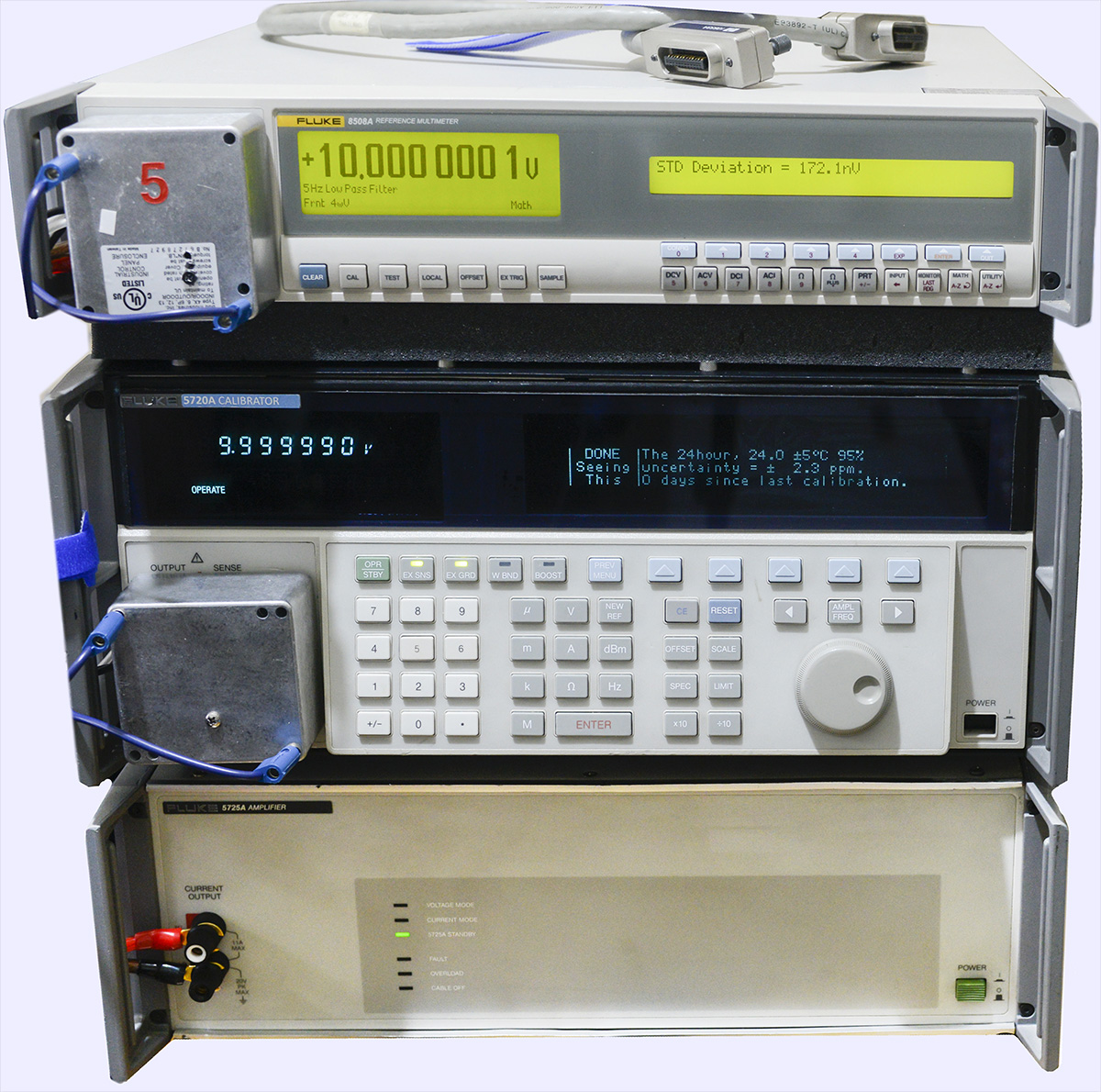 DC Voltage function comparison
DC Voltage function comparison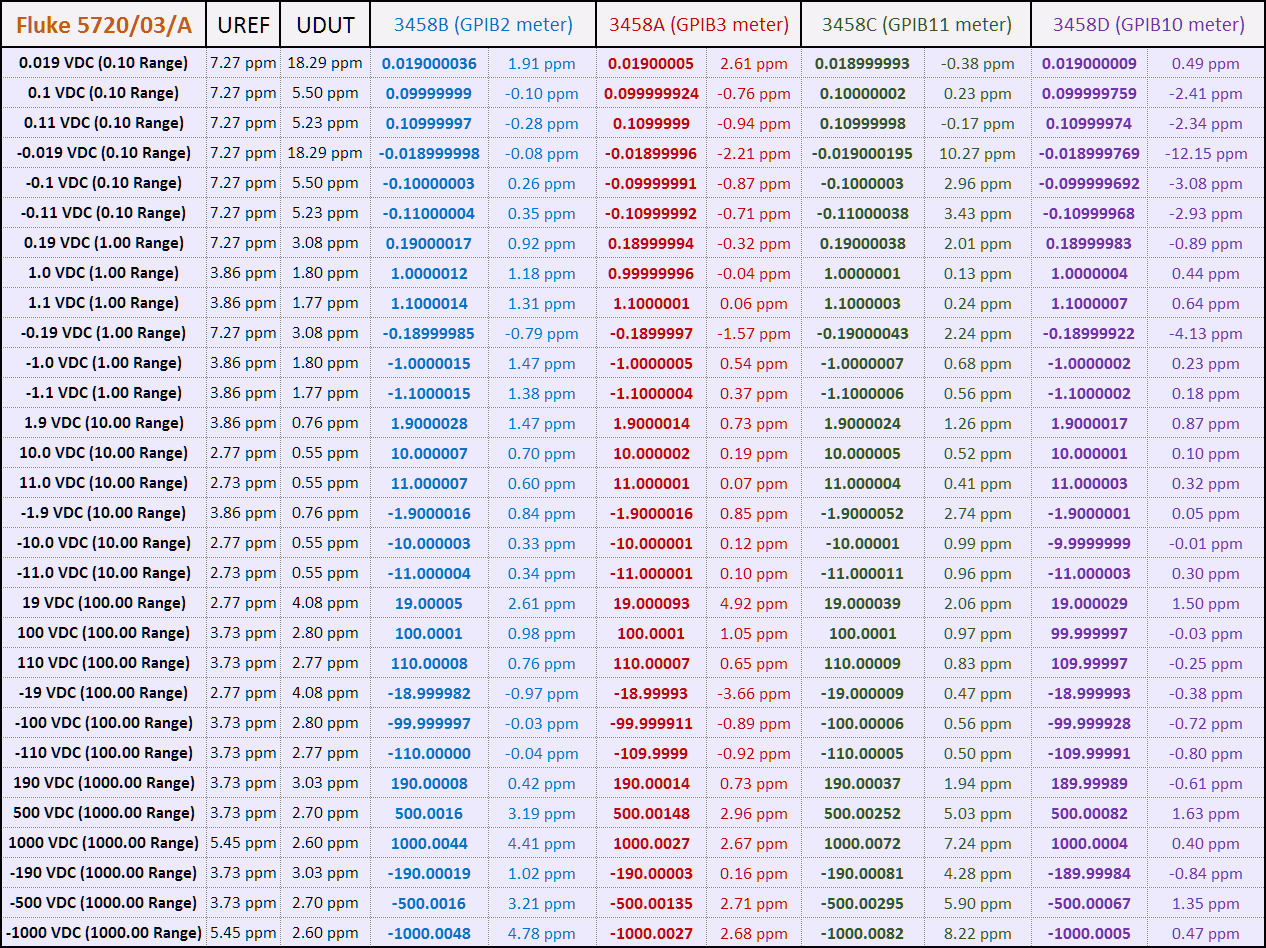
Each function range tested in both polarity, with 19%, 100% and 110% point, except 1kV range, which was tested at 19%, 50% and 100% point. All measurements are collected and combined MFC+DMM error from ideal value is calculated. Same test and procedure repeated for each DMM individually.
All measurements are taken with NPLC 100, AZERO ON after ACAL ALL, with floating DMM guard. Calibrator passed zero calibration shortly before each test run.
This is overly strict test conditions because actual ACAL procedure on both 5720A and 3458A was NOT performed within the same 24-hour but on a much longer interval. We can see that few points on specific meters are slightly over the limits, such as +19 VDC, -19VDC on 100V range for 3458A (GPIB3) DMM and +500V, +1000V and -190V, -500V, -1000V for 3458C (GPIB11) DMM. Such test highlight the importance of using multiple DMMs to improve confidence on the actual lab capability. Even if one or two DMMs demonstrate worse accuracy, other meters can act as guardband providers on problematic tests.
Resistance function comparisonThe same test repeated for resistance function, using 4-wire connection, DMM’s offset compensation function. Configuration of each meter was maintained same, and 100 &Omega – 100 kΩ ranges used OCOMP 1, DELAY 0.5 setting to mitigate cabling effects issues, as recommended by Keysight 3458A documentation.
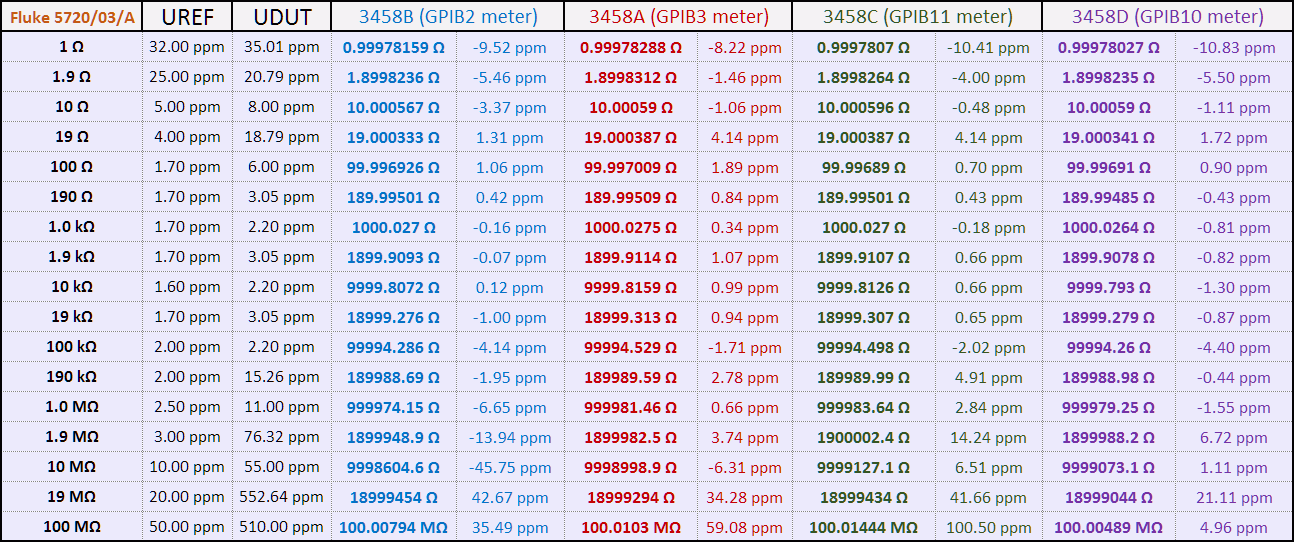
Each range was tested on 19% and 100% point, with reference resistance points provided from Fluke 5720A/03 calibrator. EXTSENSE is active on a calibrator, to enable the use of true 4-wire Kelvin connection to eliminate the impact of the cable resistance. Calibrator and DMM under test connected with 45 cm length Belden 8719 low-thermal copper spade lug cable set, similar to Fluke 5440A-7003.
The graph reveals 100 kΩ point slightly towards low 24-hour specification limit, perhaps some more finetune is required for optimal settings. Currently, each point is sampled 30 times, and median of last 5 readings is taken as the final result. Other points reveal no issues, and system error for 100 Ω – 19 kΩ points is less than ±1.9 ppm, which is quite impressive.
AC Voltage function comparisonAC Voltage test is done in a similar manner, with test points:
10 mV to 750 V AC, with 1x and 3x steps.
Same 45 cm Belden 8719 spade-lug cable set
Frequency points 10 Hz, 20 Hz, 40 Hz, 100 Hz, 1 kHz, 10 kHz, 20 kHz, 50 kHz, 100 kHz, 300 kHz, 500 kHz, and 1 MHz
30 V tested with frequency up to 500 kHz
100 V tested with frequency up to 100 kHz
300 V tested from 100 kHz to 50 kHz, Fluke 5725A booster activated
750 V tested with points 100 Hz, 1 kHz, 10 kHz and 20 kHz, Fluke 5725A booster activated
Please click on the images to see full details on each item.
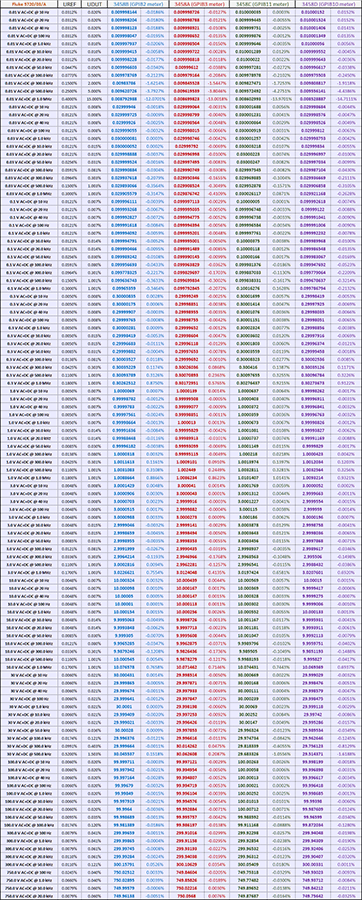
All 3458A’s configured with LFILTER ON, SETACV SYNC, DELAY 0, NRDGS 1, APER 0.6, RES 0.00001 command set. EXTSENSE is disabled on the calibrator for all points, only HI/LO connection is used.
DC Current function comparisonCurrent sourced from Fluke 5720A AUX output, with EXTGUARD disabled.
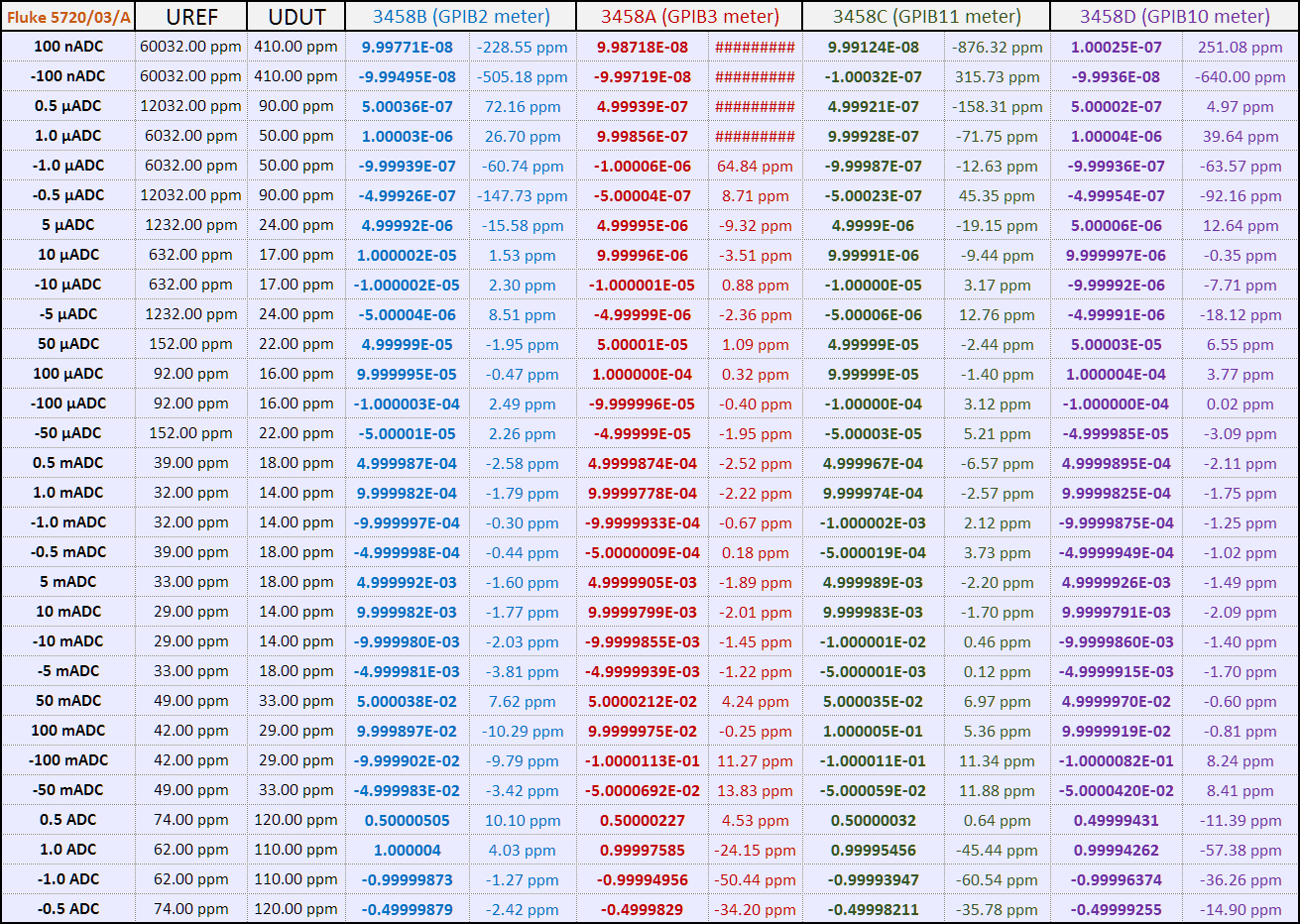
Each range was tested on 50% and 100% point in both polarity outputs. Calibrator and DMM under test connected with 45 cm length Belden 8719 low-thermal copper spade lug cable set, similar to Fluke 5440A-7003. This test also clearly shows weak point, using calibrator to source currents below 100 µA due to noise floor limitation on lowest 220 µA current range. Using low-current source, such as Keithley 6430 would be better option for 3458A low current range verification.
Okay, this is all great, but WHY do this for home lab?Now to answer the final question “Why one should ever need to maintain SI traceable accuracy for the lab?”. Annual uncertainty at even 2.0 ppm (0.0002%) already well below what most DMMs can achieve?
Such accuracy is important when we need to calibrate our 7½-digit calibrators or 8½-digit DMMs in-house on a periodic basis, often more frequent than once a year. Doing this externally would cost a fortune, so in fact, we performed this SI calibration to save cost. Establishing “xDevs Volt and xDevs Ohm” in long-term is actually cheaper to shipping high-end instruments such as Keysight 3458A to expensive external calibrations. 3458A’s calibration fee by Keysight Primary Standards Lab (which is also using JVS) is $2140 USD, shipping/handling excluded. Calibration for Fluke 5720A calibrator is even more expensive. Example cost breakdown is shown:
4 x Keysight 3458A/X02 $2140 USD each
2 x Keithley 2002 $1760 USD each
1 x Datron 1281 $1500 USD
1 x Fluke 5720A/5725A $4900 USD
Shipping and handling, 120kg pallet ~$1000 USD
Total one-time calibration cost $17720 USD
Only highest performance equipment is included in the list, however our lab has much more things that would need to be calibrated, such as AC transfer standards (Wavetek 4920, 4920M, Fluke 792A, TVC sets), SMUs and Electrometers, Keysight and Keithley nanovoltmeters, multiple resistance standards from Fluke, Guildline, L&N, resistance transfer standards like ESI SR1010/1030 series, ESI 242 bridges, etc. Also, some of our equipment is obsoleted a long time ago and special purpose, such as Keithley 1801 nanovolt amplifier and only a few commercial calibration labs have expertise about such things.
If we want to keep all these instruments calibrated externally and perform this service annually, the expense of keeping these instruments traceable and calibrated would be many times the cost of the instrument. Add the risk of damage, possible insurance costs, taxes and downtime in lab operation to get a better estimate, that high-end calibration can get very expensive fast, so only larger size business can afford to keep their instruments in best accuracy shape.
xDevs.com members are doing only non-profit research without external financing, so shipping all our precision equipment for external calibration is not a viable financial or logistic option. In this perspective investment into having in-house cardinal DC Voltage / Resistance standards and self-calibrating instruments such as Fluke 5720A, Fluke 752A, 720A, and Keysight 3458A DMMs provide a way to sustain high accuracy experimentation, with reduced financial effort. We will continue to maintain traceability to SI thru DC references and primary resistance standards in the future.
SummaryITRI CMS team and Dr. Shih-Fang Chen were very helpful during the calibration service, explained all the aspects in great detail and granted permission to publish and demonstrate how real National Measurement Lab is operating. It is amazing to see such advanced equipment in real life, as we see thousands of man-hours work put into results, invested by top-level international metrology research and engineering.
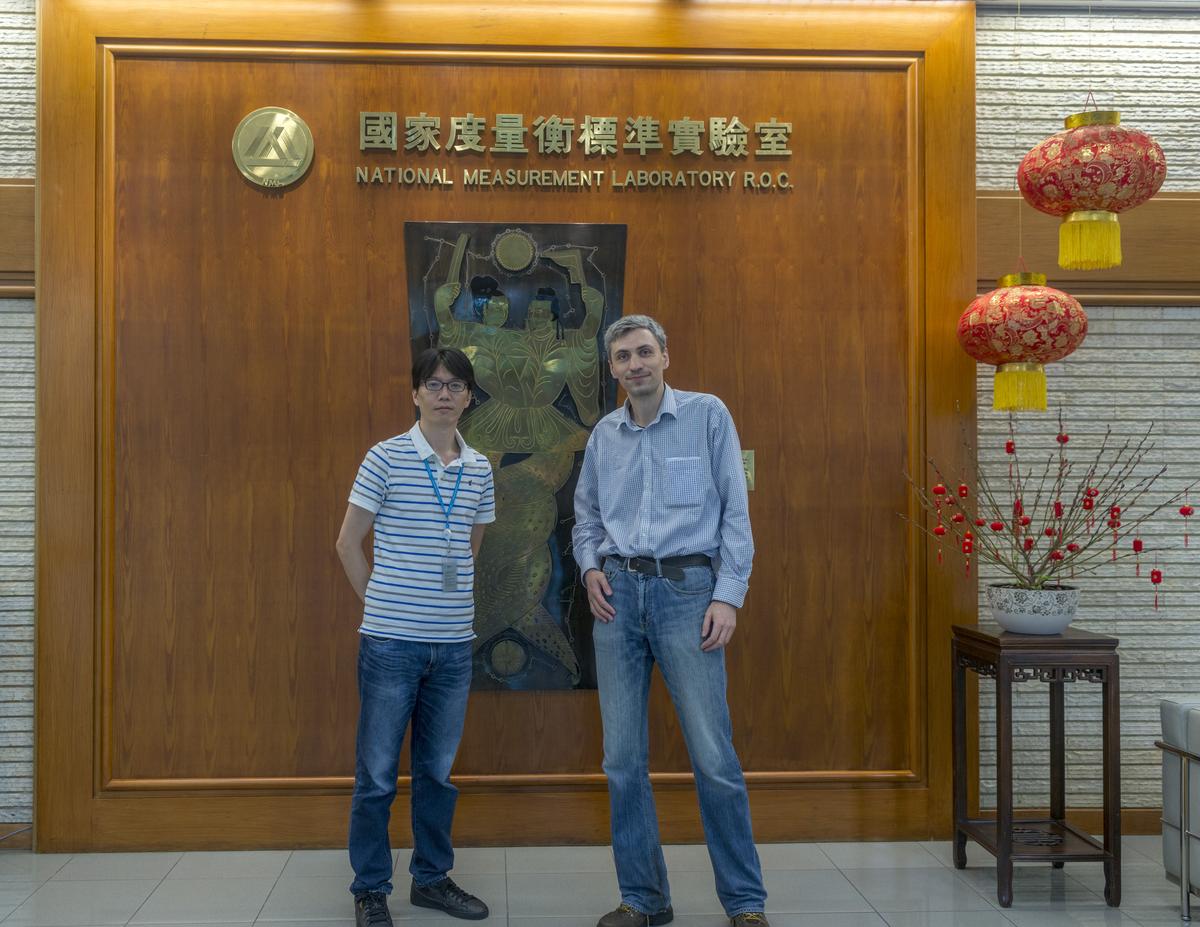
This work and results would not be possible without the help of our readers and supporters, including donations and contributions. Special credits to go fellow USA Lab maintainer Todd M. and his decade-long efforts to keep the hobby-type lab in check for absolute accuracy. I have used his standards to perform transfers for Volt/Ohm during August 2016 meetup, and now with direct comparison to new SI Volt and Ohm, done by Taiwan’s NML CMS we see results of all that effort exceeded even our optimistic expectations.
Hopefully, this article can convince other metrology enthusiasts to reach out their nearest NMI to improve their own lab accuracy and have better confidence in measurements. Some may call all this serious case of volt-nuttery without any practical use. But I’d like to respectfully disagree, as the very device you use right now to read this electronic article is made possible because of advanced technology, made possible by a better understanding of physics and thousands of difficult measurements in process.
We wish to see more of such research, be it hobby level or science, helping to share and preserve complex knowledge about precision electronics and science of measurement in general, including repair or use of aged by still very capable secondary market instruments and references.
How must does such calibration cost? Well, that, and more photos/detail coverage
revealed at my site. Also if you like to discuss related topics in real-time - feel free to join xDevs chat (links in my sub)

.